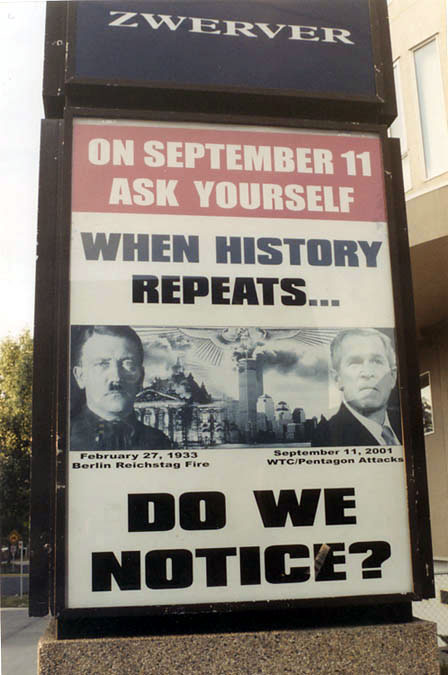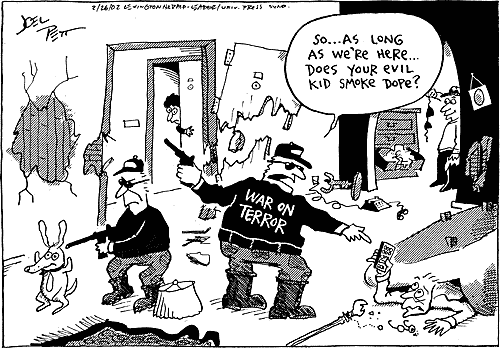
Tell-A-Vision = Why Not Try Love Again?
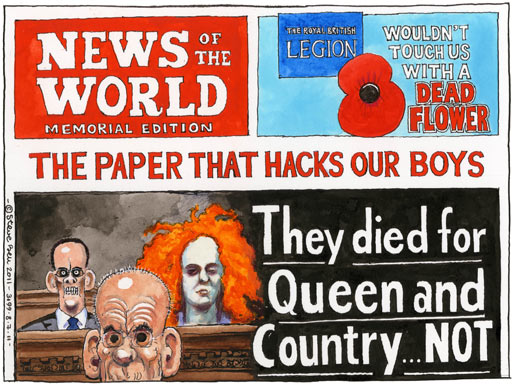
Steve Bell on the closure of the News of the World
Rupert Murdoch has acted with characteristic ruthlessness by closing Britain's best-selling Sunday newspaper
Grace Dent: 100 things about me and Twitter

Grace Dent: Twitter addict. Photograph: Chris Floyd.
by Grace Dent, guardian.co.uk, Thursday 7 July 2011 20.00 BST, Article history, Article Source
When the writer joined the social network three years ago, she used it to share random thoughts about TV and life. Since then, she has become a Twitter addict. In an extract from her new book, she explains what she loves – and hates – about it
1. My name is @gracedent.
2. I joined Twitter on 4 June 2008.
3. @febake was the first person to tell me about Twitter. It took him several months of preaching about its wonders until I cracked.
4. My first ever tweet was: "looking puzzled at twitter." No one replied. I mooched off into cyberspace, humiliated.
5. I returned in early 2009 because my friend @heawood joined.
6. We swapped twitpics of bears in Victorian bonnets and insults about body hair issues. I dumped all my surplus silly thoughts there about EastEnders, Big Brother and columns I couldn't be bothered to write.
7. By July 2009 I had about 5,987 followers.
8. Back then I said pretty much whatever I wanted on Twitter. It was like spraying rude words on a fence in neon, foot-high letters and never, ever getting detention for it.
9. Today on Twitter I feel like a slightly feral village elder. My teeth itch when people tweet me to tell me what I'm not allowed to say.
10. When @heawood moved to LA to interview movie stars, we kept in touch mainly via Twitter. I missed her so much I tweeted her YouTube links of sad songs.
11. Maudlin soft-rock ballad So Far Away by Dire Straits was most effective. @heawood now lives back in London.
12. I check Twitter on my iPhone each day within five minutes of opening my eyes.
13. I have woken myself up in the middle of the night checking Twitter in my sleep.
14. I think I can tell if you are fibbing about being on Twitter within one minute of talking to you.
15. I think I can tell if a person has enough "voice" to write a whole novel by simply reading a few tweets.
16. My most retweeted tweet was a profound quotation by Albert Camus rallying against nihilism.
17. That is a lie. It was a screen-grab of X-Factor boyband member Harry Styles looking like he had a massive erection.
18. My second most RT'd tweet was a scan of the undercarriage of a white cat with pink paws who had sat on a scanner machine.
19. I know people who monitor the success of every thought by its RT tally. I am not one of those people.
20. But if a tweet gets NO replies at all, it makes me edgy.
21. As I type this list I've got 54,851 followers.
22. As I type this list I've tweeted 27,325 times.
23. As I type this list I'm telling myself 90% of those 27,325 tweets were probably quick @replies to people and NOT actual posts in my timeline, because this makes it less of "a problem".
24. I use Twitter clients and apps like TweetDeck or Echofon. I suspect they give me migraines but I just take codeine and carry on, for how can I monitor the universe in real time without multiple columns?
25. Twitter definitely made me more well known. I'm not sure if it made me more well liked.
26. I once said on an ITV2 show that X-Factor contestant Stacey Solomon was "not a terribly good singer" and had to leave Twitter for two weeks due to an angry twitchfork mob chasing me around cyberspace.
27. Grace Dent has been a "trending topic" on a few occasions. It's not very nice really. It just opens you up to a global level of maniac.
28. Twitter led to me watching two weeks of all-night Olympic curling with @emmak67 and hundreds of other tweeters. I still do not understand curling. It looks like Olympic-grade housework.
29. I've spent New Year's Eve on Twitter. It was better than going out.
30. Twitter led to me to keeping an emergency picture of a member of the rock band Kiss sneaking to a festival Portaloo just to cheer Twitter buddies up.
31. Twitter led to @gracedent being close personal chums with the pop star Will Young.
32. After several direct-message exchanges it turned out not to be Will Young, just a man pretending to be him while pulling furiously at his own penis. @gracedent was disappointed.
33. I often see that @gracedent has blocked someone "for absolutely no reason". There has ALWAYS been a reason.
34. I sometimes block tweeters who demand I retweet them without even saying hello first.
35. I sometimes unfollow tweeters for RTing praise about themselves.
36. I still class it as RTing praise if they've cunningly added "THIS PERSON MUST BE MAD TO SAY THIS!!" on to the end of the tweet.
37. I once blocked @emmak67 during a row over politics to make a point that she was getting on my tits. Then, due to technical malfunction, I couldn't unblock her for a week, which led to a month-long row.
38. I think the most boring tweets in the world are DJs' "I'm at an airport" tweets.
39. Although any "I have jet lag. Boo-hoo, I'll just order room service then" tweets are fractionally worse.
40. I would love to punch the person in the throat who thinks it's a worthwhile task to set up a "sausage" bot. Or a "radiator" bot.
41. I love tweets featuring talking cats, snoring cats, cats jumping in boxes, cats jumping out of boxes etc.
42. I think there's a strong pro-cat propaganda unit working on Twitter.
43. I think there's either a worldwide dearth of clips of dogs being idiots, or the pro-dog lobby needs to up its Twitter game.
44. I suck at Twitter hashtags games. I tend to sit those games out.
45. I bloody love Twitter "pun" games. I'll play them until the bitter end, when my puns need brackets to explain and no one replies.
46. I get arsey when non-Twitter people say Twitter is just people discussing their breakfasts. Only an idiot tweets their breakfast.
47. I do sometimes tweet about lunch.
48. Twitter has made me seriously wonder if chronic pedantry is a social illness. People are crucified by their need to correct commas.
49. I think if you cancel an appointment with me due to being busy or ill you should have the common sense to stop fucking tweeting.
50. I believe 3,000 followers is the point at which lots of tweeters start behaving like utter maniacs. "3,000 follower syndrome" is a worrying medical condition.
51. The first sign of "3,000 follower syndrome" is apologising for not checking in on Twitter until later than usual, believing that Twitter must have felt so empty without you.
52. The second sign is placing tweets in your timeline answering the question you say "everyone" is asking you. If you check this person's @ column it almost invariably turns out no one is speaking to them.
53. It gets even worse after that.
54. Twitter led to me chatting to Curt Smith from Tears for Fears. Me being the 11-year-old @gracedent who has Smash Hits on order from the newsagent and thinks this is very cool.
55. @simonjclebon once tweeted @gracedent but she was too shy to tweet back. @gracedent left him hanging.
56. I've left Twitter several times in a massive strop.
57. But I always, always come back.
58. I worry that I can never leave Twitter as normal life feels like wading through treacle.
59. I worry that I'm missing out if I don't check Twitter.
60. I worry that Twitter has killed my ability to focus on one thought for more than 10 seconds.
61. I love it when other tweeters drastically announce they are leaving Twitter in a dramatic way. I call this "dumbass digital suicide".
62. I make rude noises at my screen when tweeters @ me to say they're unfollowing me. I'm not Moses, we weren't going to the Promised Land. Follow whoever you want.
63. I unfollow my friends all the time. I think life's too short to have someone pissing you off in your timeline. It's like radio interference in your brain on a lovely day.
64. I'm freaked out by people who use "have you unfollowed me?" software to monitor who has digitally dumped them. Is there not enough pain in the world already?
65. I dread receiving the "very terrible oh-why-have-you-unfollowed-me boo-hoo email of doom".
66. I think we focus too much on celebrities' contribution to Twitter. Celebrities aren't the tweeters providing interesting content. I discard them and their third-rate Twitter jibber-jabber all the time.
67. I unfollowed @piersmorgan for reading out his follower account figures all the time and begging for more like a telethon.
68. I unfollowed @Lord_Sugar for RTing questions asking where we could buy his book.
69. I unfollowed @ladygaga as she drones on all day about her "little monsters" like a saleswoman flogging U-bend germ-killer detergent.
70. I unfollowed @KimKardashian out of sheer pettiness because I like to believe I corner the market in "brunettes with big arses who contribute very little to the world of entertainment".
71. I unfollowed @rustyrockets after his stag do ended up in Stringfellows. I was on a militant feminist tip that day, someone was going to get it.
72. I unfollowed @50cent because the poor man is almost entirely fixated on the daily happenings of his own penis.
73. I unfollowed @BarackObama because it turns out being Mr President is a whole lot of paperwork. Mate, there's a reason I don't tweet my VAT return.
74. I send 10 tweets a month to pop star Peter Andre giving him feedback about his career but he never replies.
75. I hate the terms "tweet-up" and "twunk".
76. I love the term "twitchfork mob".
77. When twitchfork mobs are circling some poor tweeter for crimes of thought I often add the rumour "I heard he bummed a puffin" simply to cheer myself up.
78. I love the term "twanking" (wanking while tweeting).
79. I get tweeted quite a lot of pictures of penises and offers of sex. "I fink we should make a play date 4 our GENITILZ!" one man wrote this very morning.
80. I get at least one unsolicited tweet a week from a stranger pointing out that in my current state of vast ugliness they'd never fuck me.
81. I think if one morning everyone's direct-message box was suddenly, accidentally posted in the public timeline there would be rioting in international cities by lunch time. Most of this would be warring couples chucking bin-bags of clothes at each other.
82. I think most people don't realise that posting a photo on DM means EVERYONE who looks at your photo account can still see it. It's not private. I've seen two photos of my friends I wish I hadn't.
83. One of them was in the bath.
84. The other one was indescribable but it scarred my retinas.
85. I've seen perfectly good marriages go down the pan because of Twitter.
86. I genuinely cringe at my friends publicly arse-kissing each other on Twitter.
87. I find the way some people blatantly social climb on Twitter vomit-making.
88. The phrase "let's have a tweet-up" makes me nervous. I don't think meeting people off Twitter is necessary to be friends with them.
89. I never like Twitter "tribute" sites where someone pretends to be someone else. I think they're usually one joke stretched very, very thinly in search of a toilet book deal.
90. I know Twitter is the only place I can make jokes about my family, because, as of yet, they're not on Twitter. Once they join, it's all over.
91. I think the future of social networking lies in tackling the need for an individual to have "multiple personalities" living easily on one social networking platform. We are not one person all of the time, not even minute-to-minute.
92. I think there should be a meta-Twitter for gossiping about what we think other people are up to on Twitter.
93. At the moment I sometimes flip to Skype to chat face-to-face with friends about what we think the story is "behind the tweets". It's like Minority Report, but in pyjamas.
94. I get emails once a week from TV companies who say they want to "harness the power of Twitter but ON TELEVISION". They then fart around with meeting for 10 weeks and realise it's impossible.
95. This book is just a whole lot of my own personal thoughts, feelings and experiences of Twitter. I'm pretty certain you'll disagree with most of it.
96. I chatted to scores of people about Twitter as I was writing the book. Absolutely nobody agreed with anyone else's view on anything.
97. Everybody brought fresh angles and topics I'd never even thought of. I love this. Twitter is a totally different animal to everyone riding it.
98. I agreed to write How to Leave Twitter after a publishing meeting about a different book turned into an extended rant about RTs and Follow Fridays.
99. I showed some parts of the manuscript to good friends as I worked who went slightly ashen and said, "Grace, you're going to break Twitter, you do know that, don't you?" In a way, this is brilliant. Killing Twitter is my only real chance of leaving.
100. I'd have delivered How to Leave Twitter a lot earlier to the publishing house and avoided a lot of stress and shouting matches, but in all honesty, I was too busy dicking about on the internet.
Old German Shepherd
via Joe
One day an old German Shepherd starts chasing rabbits and before long, discovers that he's lost. Wandering about, he notices a panther heading rapidly in his direction with the intention of having lunch.
The old German Shepherd thinks, "Oh, oh! I'm in deep shit now!"
Noticing some bones on the ground close by, he immediately settles down to chew on the bones with his back to the approaching cat. Just as the panther is about to leap, the old German Shepherd exclaims loudly,
"Boy, that was one delicious panther! I wonder, if there are any more around here?"
Hearing this, the young panther halts his attack in mid-strike, a look of terror comes over him and he slinks away into the trees.
"Whew!," says the panther, "That was close! That old German Shepherd nearly had me!"
Meanwhile, a squirrel who had been watching the whole scene from a nearby tree, figures he can put this knowledge to good use and trade it for protection from the panther. So, off he goes.
The squirrel soon catches up with the panther, spills the beans and strikes a deal for himself with the panther.
The young panther is furious at being made a fool of and says, "Here, squirrel, hop on my back and see what's going to happen to that conniving canine!"
Now, the old German Shepherd sees the panther coming with the squirrel on his back and thinks, "What am I going to do now?," but instead of running, the dog sits down with his back to his attackers, pretending he hasn't seen them yet, and just when they get close enough to hear, the old German Shepherd says....
"Where's that squirrel? I sent him off an hour ago to bring me another panther!"
Moral of this story....
Don't mess with the old dogs... Age and skill will always overcome youth and treachery! Bullshit and brilliance only come with age and experience.
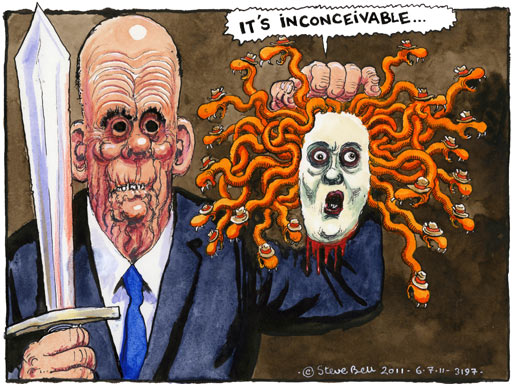
Steve Bell on Rupert Murdoch, Rebekah Brooks and phone hacking
SmartMeter Opponents Step Up Tactics
By Alastair Bland Mon, Jun 27, 2011

Stop SmartMeters! founder Josh Hart was arrested June 21. Photo by Chip Scheuer.
The wildfire of rebellion against PG&E's plans to install SmartMeters in households across the state is growing hotter by the day. Before sunrise on Monday, June 27, about 50 demonstrators surrounded the gates of a PG&E yard in Capitola to keep workers from exiting and installing wireless SmartMeters in local neighborhoods, as PG&E had announced would happen that day.
"We were ready to block them in, but the Wellington (Energy Company) workers (contracted by PG&E to conduct the installations) never materialized," said Joshua Hart, the director of Stop SmartMeters!
Hart says local residents are watching the fleet of about two dozen Wellington Energy trucks and will report any indication that they are preparing to leave the premises.
Monica Tell, a PG&E spokesperson, confirmed that PG&E has contracted Wellington Energy, based in Pittsburgh, Penn., to install SmartMeters. She said the company will attempt do so sometime this week.
Hart assures he'll try to block any such efforts to install the wireless energy meters, which he and others believe emit dangerous levels of radiation and which several local governments have banned. On June 21, in fact, Hart was arrested minutes after blocking the entrance to PG&E's administrative office at Capitola Mall. Hart says he was demonstrating in direct response to an announcement from PG&E that it would soon resume installations of SmartMeters in the area, from which it had desisted for several months. Officers with the Capitola Police Department charged Hart with disrupting a business and released him with an order to appear in court on July 28.
"With PG&E's arrogance in ignoring our local laws I felt I had to put my own body in their way," Hart explains.
Pleasure Point SmartMeter Arrest
The Capitola Police Department did not return a call seeking comment.
Hart, who launched his anti-SmartMeter nonprofit about a year ago, is among a vocal group of people that claim SmartMeters are hazardous to human health. In May, the World Health Organization classified the radiofrequency electromagnetic fields emitted by cell phones and wireless communication devices as "possibly carcinogenic to humans." Though the WHO looked mostly at correlations between cell phone use and cancer, SmartMeters, as their critics have pointed out, emit the same kind of radiation as cell phones and wifi routers.
In spite of local bans on SmartMeters in Capitola, Watsonville and other parts of Santa Cruz County, Tell at PG&E says the energy giant recognizes no authority beyond the state's Public Utilities Commission.
"The CPUC is the only entity with jurisdiction to impose moratoriums on SmartMeter installation," Tell said.
In Capitola, where the city council last year voted to temporarily prohibit SmartMeters, councilman Kirby Nicol--the lone vote against the ordinance--says city and county laws have no power to deflect an initiative with federal backing. He said that any local-level opposition to PG&E's SmartMeter plan will amount to just "a political game."
"We have no authority to do anything (to stop SmartMeter installation)," Nicol said.
But SmartMeters may not be mandatory for all customers. In March, PG&E proposed an "opt out" plan by which customers can pay an upfront fee of up to $270, plus a monthly fee of $14-20 thereafter. Pending approval of the plan by the CPUC, customers opposed to SmartMeters can call 866.743.0263 to be placed on a delay list.
Hart--who says he is ready to be arrested again--says local representatives have a responsibility to block PG&E's advance entirely.
"We believe that the local government has the right and even the obligation to step in and stand up for the community if the state or federal government won't do it," he said. "We have laws against SmartMeters here, and if the local government can't enforce them, then what's the point of having them?"
According to WHO: PG&E and CPUC Are Harming Humans and
PG&E Uses Local Police To Protect SmartMeter Installation Atrocities

Download a Do Not Install the Smart Meter sign - www.turn.org
World Health Organization has classified SmartMeter
Radiation as "possibly carcinogenic to humans."
TIME FOR A CORPORATE DEATH PENALTY!

This Richard is a War Criminal
Oil spill in Yellowstone River in Montana by Exxon
Topic started on 2-7-2011 @ 03:11 PM by Vitchilo on Above Top Secret
Statement by ExxonMobil Pipeline Company Regarding Crude Oil Release into Yellowstone River in Montana
"Early on the morning of July 2, we discovered an undetermined amount of crude oil was released into the Yellowstone River from an ExxonMobil Pipeline Company (EMPCo) pipeline. EMPCo deeply regrets this release and is working hard with local emergency authorities to mitigate the impacts of this release on the surrounding communities and to the environment.
The release originated from a 12" crude pipeline operated by EMPCo that runs from Silver Tip, MT to Billings, MT. The pipeline has been shutdown and the segment where the release occurred has been isolated. All appropriate state and federal authorities have been alerted.
Demystifying 9/11: Israel and the Tactics of Mistake
by Alan Sabrosky via Prez, USA-Exile
Many years ago I read a fascinating discussion of the "tactics of mistake." This essentially entailed using a target's prejudices and preconceptions to mislead them as to the origin and intent of the attack, entrapping them in a tactical situation that later worked to the attacker's strategic advantage.
This is what unfolded in the 9/11 attacks that led us into the matrix of wars and conflicts, present (Afghanistan and Iraq), planned (Iran and Syria) and projected (Jordan and Egypt), that benefit Israel and no other country -- although I concede that many private contractors and politicians are doing very well for themselves out of the death and misery of others.
I am also absolutely certain as a strategic analyst that 9/11 itself, from which all else flows, was a classic Mossad-orchestrated operation. But Mossad did not do it alone. They needed local help within America (and perhaps elsewhere) and they had it, principally from some alumni of PNAC (the misnamed Project for a New American Century) and their affiliates within and outside of the US Government (USG), who in the 9/11 attacks got the "catalytic event" they needed and craved to take the US to war on Israel's behalf, only eight months after coming into office.
Genesis of the Deception
That was not how it seemed at first, of course. Lists of names and associations of the alleged hijackers quickly surfaced in official US accounts and mainstream media (MSM) reports, pointing to Osama bin Laden and his Al-Qaeda group, then largely in Afghanistan. Bin Laden denied responsibility, saying in effect that while he thanked Allah that the attacks had occurred, he had not done it, but the US demanded that the Taliban governing Afghanistan turn him over to the US. The Taliban response was reasonable: "Show us the evidence he did it and we'll give him to you." But the US brushed it off and attacked. Why? Because it had no convincing evidence, and never would -- even on the eve of his public death in 2011, the FBI did not include 9/11 on his internet-based "Most Wanted" charge sheet.
As the war in Afghanistan for very dubious reasons extended into a war in Iraq for even more specious ones, the essential USG view of 9/11 became embedded in the public ethos. The 9/11 Commission Report, despite being handicapped when it was prepared and later revealed to have been deeply flawed, still appeared as the basic reference work on the attacks. Details may have been compromised, but the prevailing view was that 19 Arab hijackers had flown four planes into three buildings and one crash site, and that was the end of it. This was the position taken by the Bush Administration in 2001, and reaffirmed a decade later by the Obama Administration. Politicians of every stripe, most pundits and rafts of Protestant pastors (mainly evangelical) added their endorsements.
Neither I nor most Americans had any particular reason to doubt the veracity of these claims, then or later. Nonetheless, I had strong suspicions that something was very wrong with the official US account of the tragedy only weeks after the incident, while responding to a request from a local journalist for background information. Too much made no sense whatsoever: warnings after the fact when there should have been no warnings, bizarre misbehavior by the alleged hijackers that ran counter to both the mission and their faith, skills required that far exceeded any skills the named hijackers themselves could ever have possessed for the mission, and especially the total absence of any recognition for what they had done from anyone except their supposed victims – something without precedent for actions of the sort that supposedly happened on 9/11. These and similar discontinuities reinforced my suspicion that something in the entire exercise was rotten to the core.
Potentially far more significant than individual musings was the gradual appearance of dissent that eventually crystallized in the so-called "9/11 Truth" movement, which rapidly proliferated into scores of major and many minor organizations and websites dissecting the attacks, the Commission report, the motivations and agendas of assorted elected and appointed officials, and alternatives to the orthodox view. But "9/11 Truthers" have been doing their version of the Maoist "Hundred Flowers" Campaign, throwing out so many different assessments of so many different aspects of so many different issues that the core message has been lost. Nor is it a matter of too little evidence invalidating the USG position on 9/11 being available, but too much to permit a clear focus on what happened (so many trees no one can really see the forest).
Mind you, it isn't that what has been presented is irrelevant or even necessarily wrong, although some pretty bizarre theses have been tossed around along with a good deal of thoughtful and balanced work. A substantial segment also have resisted closure under any circumstances – especially when Israel came into the equation in any way – thus keeping the rhetorical pot boiling inconclusively, more than a few for reasons that could not withstand close scrutiny as to their affiliation and motivation.
Critiquing the 9/11 Critique
The real difficulty with much, but not all, of the effort to critique and question the official US position on 9/11 is that the "9/11 Truth" proponents have been unable to communicate their concerns – much less any conclusions – to the general public in any significant way. So much of the discussion is only partially comprehensible to some within the movement, largely unknown to the general US public, and so complicated in all its dimensions to those who do become aware of it that they fail to follow up on the arguments. It is as if critics of the official position on 9/11 have been attempting to try the case in court before they have even gotten an indictment – the analytical equivalent of putting the argumentative cart before the public horse of the need to rethink the issue, thereby creating an evidentiary Gordian Knot of sorts.
This analogy has long struck me as an appropriate way of rethinking our approach to the 9/11 controversy. It is not that the issue isn't complex – it is, in ever so many ways, and that complexity would have to be addressed at some point, but there is no need to confuse the public with its complexity at the very beginning.
Remember that at least in the US, the evidence and voting requirements are very different in a grand jury which can issue an indictment, than they are in a petit jury that actually tries the case. The latter needs proof of guilt; but the former only needs sufficient indication that a specific crime may have been committed, and that the accused may have done it. That is where we need to go, and where I will take this argument: to focus on those essentials necessary for an indictment in a way that will be understandable and credible to a reasonably intelligent person without requiring them to have the skills of (e.g.) a civil engineer or an aviator.
Peeling Away the Layered Details
There are so many flaws in the official US Government's position on 9/11 that it is sometimes difficult to know just where to start. For example, the miraculous survival of a passport, used to identify one of the hijackers, which somehow worked its way through the aircraft's impact, explosion, fire, and an 800-plus foot free-fall to be found by a well-dressed man and given to a New York City police detective at the base of the twin towers is a standout. The superstar-like ability of named pilots to go from the controls of a single-engine propeller-driven light plane to the cockpit of a passenger airliner and do anything except put it into the ground within a minute of turning off the autopilot is another – who would ever have thought that the Microsoft Flight Simulator program was so superlative? And the explanations given for the multiple failures of NORAD (the North American Air Defense Command) to have fighters on all four planes within minutes of their straying off course are individually dubious and collectively preposterous – only in Hollywood would they have any credence, perhaps because that is where they originated.
The debate on these and many other points, and the implications thereof, has been extensive and sometimes ferocious, even if not particularly effective. What is not open to debate, however, is that WTC-7 -- the third tower to collapse that day, and the only one not hit by a plane -- absolutely was brought down by a controlled demolition, as anyone not trying to shield the attackers knows from a real-time video of its collapse. That is, WTC-7 went straight down into its own footprint in seconds without any visible catastrophic external trauma, which means only some catastrophic internal trauma could have brought it down. And if it had been wired for a controlled demolition, then so were the other towers (WTC-1 and WTC-2) that collapsed. That gives the plane impacts a gruesome cosmetic role, designed explicitly to conceal the true cause of the collapse of the buildings, while shocking the public into something akin to numbness.
The case of WTC-7 has long been known to critics of the US government position on 9/11. What does not seem to have been fully appreciated, at least at first (this is changing somewhat now), is that it is not merely "an" issue, but the single issue that can be used simply, directly to the American public, and effectively to discredit the US Government's case, and thus its rationale for so many fallacies and misdeeds: not only needless foreign wars (Afghanistan being a "pump-priming" conflict to get the US into war in the region, and to lay the groundwork for later wars), but a substantial infringement of American civil liberties under the misbegotten "Patriot Act," the unbelievably widespread acceptance of torture (including a technique openly named "Palestinian Hanging," which assuredly did not originate in Boston and says something about Israeli habits), and the creation of known and secret prisons and detention centers in various countries.
Second only to the actual controlled demolition of WTC-7, and supplementing the thesis that with or without impacting aircraft the buildings were brought down by other means, is extensive extensive audio-visual evidence on 9/11 while the Twin Towers were still standing from what became "Ground Zero." This evidence includes real-time clips of secondary explosions at ground level in both WTC-1 and WTC-2 (you can hear the detonations and see smoke and debris billowing out), reports on many networks of those explosions and of strange vans inside and around those buildings prior to the secondary explosions, reports from EMTs (Emergency Medical Technicians) of the same thing and of people inside and around the lobbies of those buildings who were not emergency personal and were not fleeing the disaster – all of this on 9/11 and widely reported as it happened that same day.
And a third element, building on the above and adding its own dimension, is the presence of a number of (mostly white) vans owned – as far as can be determined, given the extent to which information on them and the people with them has disappeared from the public record – by an Israeli company (or rather a company owned by an Israeli, to be precise) in New Jersey. Some of these vans were regularly around the World Trade Center itself. But two stand out, and need to be examined in some detail for their significance to be appreciated.
First, Bergen, NJ residents saw five people on a white van filming the attacks and visibly celebrating. They had set up their cameras before the first plane hit. Police arrested them. All were Israelis (now referred to as the "dancing Israelis"). Bomb-sniffing dogs reacted as if they had detected explosives, although officers were unable to find anything. The FBI seized the van for further testing. All five were later released at the instigation of Israeli & American Jewish leaders, some in the US Government. Details are still classified. This incident quickly disappeared from the mainstream media, following a brief mention in the New York Times three days after the attacks, that was not followed up.
A second van was stopped on the approaches to the George Washington Bridge. As CBS's Dan Rather said in his live report: "Two suspects are in FBI custody after a truckload of explosives were discovered around the George Washington Bridge. That bridge links New York to New Jersey over the Hudson River. Whether the discovery of those explosives had anything to do with other events today is unclear, but the FBI, has two suspects in hand, said the truckload of explosives, enough explosives were in the truck to do great damage to the George Washington Bridge..." Those suspects –also Israelis -- and the incident then seem to have disappeared from the public record and mainstream media "examinations" <sic.> of 9/11, just like discussions of the first van, the secondary explosions at ground level within WTC-1 and WTC-2, and the precipitous collapse into its own footprint of WTC-7.
The combined impact of these and many other factors is both chilling and compelling. Think of it: Secondary explosions at ground level where there should be no secondary explosions. The catastrophic collapse of the 47-story WTC-7 into its own footprint in seconds, without any significant external trauma, where by rights there should have been no collapse. Vans with targeting maps, explosives or traces thereof, cameras pre-positioned to film the World Trade Center, and especially Israelis with those vans where there should have been no Israelis present with any of those things in those places at that time.
Any of these matters ought to have been sufficient to stimulate a searching re-examination of the official USG interpretation of 9/11, and especially of the actual or putative role of Al-Qaeda in it. The vans alone pointed away from Al-Qaeda, unless one assumed that Al-Qaeda was an Israeli front, or that Mossad at a minimum had run a parallel and more murderous operation to whatever Al-Qaeda may have done. What is fascinating is how little impact it has had on public awareness of the details of 9/11, much less official US policy based on it. A "cloak of silence" had descended over any official or mainstream media discussions of 9/11 that did not conform to the official interpretation, thereby keeping such dissonance from the general public.
The Cloak of Silence Over 9/11
There have been three elements to the "cloak of silence" covering efforts to expose the failings of the official US position on 9/11 to the public. One is within the Executive Branch. Another is within the Congress. And the third is the mainstream media (MSM).
The first is not at all surprising, as so many of its key members (and especially its so-called "neo-conservatives") were the authors of the "19 named Arabs in 4 planes" thesis, and its de facto apologists on the professional staff of the 9/11 Commission. Indeed, many of them had a vested personal and professional interest in maintaining the validity of the official position.
A surprising number had been on the strongly pro-Israel Project for a New American Century (PNAC) when it published a report asserting that some "catalytic event" akin to the Pearl Harbor would be needed to move the US in the direction they desired (and which would be of enormous benefit to Israel). The 9/11 attacks gave them their catalytic event, and they visibly capitalized on that opportunity. Many were Jewish, often with dual US-Israeli citizenship and a controlling commitment to Israel. All were Israeli partisans. And it took no great inferential leap to understand that a US consumed with anti-Arab and anti-Muslim rage would inevitably and inexorably do things that would directly or indirectly benefit Israel – which, of course, is precisely what has happened over the past decade.
Overtly more surprising was Congressional acceptance of the official explanation, or rather the lack of searching inquiries into it and the events of 9/11, at least by the Democrats. But in reality, that wasn't at all surprising. It was not just that Administration officials were essentially "speaking with one voice" on this issue, or that the Republicans in the Senate at least could have kept Democrats from holding hearings, at least in the beginning. It is that while many (especially Democrats) came to question later the war in Iraq, and some more belatedly the war in Afghanistan, there was and remains no discernable legislative effort to delve into the details of 9/11 – and especially the numerous contradictions, inconsistencies and unbelievable aspects in the official explanation. This is a predictable outcome of a substantial lobbying effort by AIPAC (the American-Israel Public Affairs Committee) here, "encouraging" Senators and Representatives of both parties to do in this matter what they do best – nothing – and punishing the handful who balked by marginalizing their efforts while in office, and working successfully for their electoral defeat later.
Overlapping these two branches, and a critical element in the Zionist control of the US Government that is sometimes overlooked, is their domination of the political appointment and confirmation process. The White House Personnel Office has been largely dominated by them at least since 1980, and perhaps before, thereby reducing the likelihood that people unfriendly to Israel or unsupportive of its "ways and means" will be nominated in the first place. The vetting of nominees by key organized Jewish groups in the US before they go before the US Senate for their confirmation hearings has also been a fixture of this process for decades, as Ha'aretz (an Israeli newspaper) among many others has pointed out, and forces otherwise excellent nominees to withdraw if said Jewish groups find them to be unsuitable. And the leverage of AIPAC in the US Senate is in this respect crucial: anyone AIPAC wants confirmed will be confirmed, and anyone who manages to reach that point and is not acceptable to AIPAC doesn't stand a chance.
This is why under both Republicans and Democrats, the staffs in and around the President and the Vice-President, the National Security Council, the State Department and the Defense Department (among others) look the way they do. Many are Jewish and actively Zionist, often with dual US-Israeli citizenship (not that the absence of an Israeli passport matters all that much to the others). Some are Christian Zionists who need no persuading to take the pro-Israel positions they do – I can only shudder to think of the type of a staff and appointments that would come from a president like Michele Bachmann or Mike Huckabee. Others are what the communists used to call "useful idiots," frequently intelligent people like Condoleeza Rice or John Bolton who have made their own Faustian bargain in the furtherance of their own careers. And the rest of us live with the consequences of all of them, not least of which was 9/11 and the ensuing wars.
But it is the role of the largely Zionist-owned mainstream media (MSM) in allowing the official US government view of 9/11 to go virtually unchallenged that is most fascinating, and has been most effective in letting any possible public debate on 9/11 largely lie fallow. This was contrary to its entire post-Vietnam (and especially post-Pentagon Papers/post-Watergate) ethos, which put investigative journalism on a pedestal and made a fetish of investigating and exposing corporate and government wrong-doing, both for profits and for professional advancement. Remember, that at least since the publication of the so-called "Pentagon Papers" during the Vietnam War, the normal instinct of the MSM is to investigate and to reveal, unless that discloses Israeli misconduct or reflects negatively on Israel, in which case its virtually primeval instinct is to conceal and to protect.
The MSM's normal inquisitorial impulse was not in evidence in the case of 9/11. This is because critical inquiries into 9/11 have been largely ignored or repressed by the MSM -- which would not do that if its largely Zionist ownership did not know, suspect or fear that an exposed evidentiary trail would lead, in whole or in part, directly or indirectly to Israel. Indeed, if the evidentiary trail had seemed to lead to (e.g.) Iran instead of Israel, or if its provenance was even moderately uncertain, the MSM would have vociferously shredded the USG case long ago, and the "9/11 Truth" movement would find its views presented on the front pages of major newspapers and highlighted in favorable TV/radio broadcasts.
That this did not happen quickly becomes clear as one examines the MSM's approach to 9/11. Its role has been threefold: : (a) disinformation – to affirm, or at least not openly question, the USG case; (b) distraction – to direct attention away from Israel and the PNAC/neo-cons; and (c) doubt – to ignore or ridicule those who question the official US case. What people choose to conceal speaks volumes about the dynamics of the situation, and the end result of MSM actions has been the fabrication of an aura of disbelief and doubt where there should be none.
This process began almost immediately. Dramatic and revealing real-time reports about the details of the attacks appeared on 9/11, including many that did not directly involve the hijacked airliners. Over the next few days, some local papers and stations in the area still were reporting dissonant events (e.g., the van with the "dancing Israelis"). But within a week, most dissonance was gone or relegated to inside pages and their electronic equivalents, especially anything pertaining to WTC-7, whose collapse became a non-event, or the presence of Israelis in the vans and elsewhere, as the US Government's propaganda machine – aided actively by most of the MSM – went into high gear first against Al-Qaeda and then in support of the invasion of Afghanistan.
The Path to 9/11
The provenance of the 9/11 attacks becomes even clearer once they are examined as a classic exercise in covert operations. Generally speaking, there are three requirements for evaluating the origin and prospects for success of all covert intelligence operations: (a) motivation, (b) expertise, and (c) local support for access to the target and post-attack evasion and escape.
Let us look first at motivation. It is a bitter commentary on how far the US has gone from its strategic requirements and its own principles that so many movements and governments around the world not only dislike and distrust the US, but hate it with a passion and with better cause than I care to think about. I recently came across a remark by a Jesuit priest to the effect that "Every time I hear that Israel is America's only friend in the Middle East, I remember that before Israel, America had no enemies in the Middle East" – a point well worth remembering.
But the interesting thing about the assorted movements and governments that might have an actual or perceived reason to do harm to the US, is that all but one has had a negative incentive to do that: to punish the US for some actual or assumed failings or misdeeds. The one exception is Israel. It has no negative incentives at all (I exclude some real fringe fanatics), simply because without US aid and diplomatic support, it would find itself in even worse straits than did apartheid-era South Africa, and with better cause. But it is the one state with a positive incentive, if it believed it could get away with it, which is to enrage the American public against Muslims generally and Arabs in particular, and to make the US an active belligerent in the region – spending American lives and treasure in the service of Israel's interests.
Expertise is different and more diffuse. There are many intelligence and special operations forces in the world with the expertise to wire large urban structures for a controlled demolition. There are many combat engineer units in many countries that could do the same thing. And there are many private firms that specialize in them as well. Yet neither Al-Qaeda as an organization, nor any of its known affiliates – much less the 19 named Arabs supposedly on those four planes – possessed that expertise, or anything even remotely close to it; had they done so, the Green Zone in Baghdad would have been a pile of rubble.
But it is local support that is the crucial determinant. All well-crafted covert operations require some measure of local support, official or unofficial, unless the target area is so irredeemably hostile that none is available. Any domestic or foreign intelligence agency targeting the WTC would absolutely have required it, and Mossad would be better placed than any other to access such support for entry, access, execution and escape.
This is especially true, given the security company overseeing the WTC. CIA and/or Defense Department personnel (which is not the same as the CIA or the Defense Department as organizations) could have had access, but only if that had Israeli endorsement – one does not casually cut open walls, implant explosives, run cables and wire everything together in buildings with state-of-the-art electronic surveillance and 24/7 on-site security. Mossad would have no such need for those niceties, given the ownership of the WTC and the management of the company overseeing its security. Remember that we are not talking about large numbers of people in any case: given time to prepare the three buildings and protection from detection, as few as a dozen could have sufficed, a number small enough to be effectively unnoticed in a large organization.
Retrospect and Prospect
So let us recapitulate the basic conclusions of this analysis. First, the core official US Government position on 9/11 is that any and all aspects of it are directly attributable to 19 named Arabs on 4 planes, conducting a terrorist operation planned and executed by Osama bin Laden's Al-Qaeda. This position is at best incomplete, and at worst a complete fabrication engineered by those directly or indirectly responsible for what happened on 9/11, and the wars afterward.
Second, Al-Qaeda and many different countries and groups had negative reasons, real or contrived, to want to harm the US. But only Israel and its neoconservative wing in the US had a positive incentive to do so, which was to enrage Americans and make the US an active belligerent against Muslim countries, thereby cementing its bonding to Israel and Israel's interests.
Third, there is no doubt that fully-loaded civilian airliners, especially with nearly-full fuel loads, impacting the Twin Towers (WTC-1 and WTC-2) would do great damage to those buildings, although even under extraordinary circumstances could not precipitate a chain of events leading to their collapse. And there is absolutely no way that those airliners impacting 800-1000 feet above the ground could have produced visible and audible secondary explosions in those buildings at ground level, nor precipitated the collapse of a third building (WTC-7)which was not hit by any aircraft and had no massive external trauma from debris produced by the Twin Towers.
Fourth, Al-Qaeda – and perhaps other groups as well – had the theoretical capability to carry out a simultaneous four-plane hijacking, perhaps flying the aircraft to Cuba (the four 9/11 aircraft should have been able to make a one-way flight there at the beginning of their operational day without difficulty, depending on their actual loads), which would have been spectacular in itself. But neither Al-Qaeda nor any of their affiliates had the expertise and local support necessary to allow them the needed access to any of the buildings at the World Trade Center, to cut open the walls and wire them for controlled demolition, and then to escape and evade afterward.
Fifth and finally, in addition to being unique in having a positive incentive to make the 9/11 attacks, only Israel had the essential expertise and local support required to bring down the three World Trade Center buildings with controlled demolitions, and the leverage within and around the US Government to let their operatives evade detection, to be released without fanfare if apprehended unexpectedly, and to cloak their actions from public scrutiny – all of which happened on and after 9/11.
People often ask about some new evidence or proof tying 9/11, in whole or in part, to Israel. Now I understand that there can never be absolute proof for some people barring a public confession from one of the Israeli planners or their American supporters, and that, I suspect, we will never obtain – although some of the statements made later in Israel by three of the Israelis arrested in Bergen, NJ filming the burning Twin Towers comes very close to that: One stated categorically that "our purpose was to document the event," which should leave little doubt that they knew in advance of the attacks, whether or not they themselves personally had any further role in them.
But it is not necessary to have such a confession, any more than it is necessary to have a confession in a criminal court to convict a person of murder, if the other evidence is sufficiently compelling. Here there is a mountain of physical, technical, analytical and circumstantial evidence, far more than any unprejudiced person needs to understand far beyond any reasonable doubt whatsoever, that (1) the USG case is fatally flawed, and (2) this was a Mossad-directed operation orchestrated at the highest levels of the Israeli government (because of the target) with local support within the US and elements of the US Government itself.
Given the pervasiveness of Zionist influence in the US government and its intelligence and security agencies (including of course the Defense Department), two broad scenarios are possible. One is that the neo-cons and their cohorts were in the driver's seat with Israel in the passenger seat with a map and the baggage. The second sees Israel driving with the neo-cons and others handling the map and baggage. But they were both in the same car on the road to and from 9/11. Both were embedded in aspects of the planning and execution of the catastrophe, the wars it spawned and the wars its architects now want us to wage in Israel's name, linking treason and treachery in tandem no matter where the emphasis is placed.
Unraveling that issue is something to be left for a future investigation, interrogations and trials, followed by punishments appropriate to the magnitude of the crimes for all of the participants. Bringing an awareness of these events to the American public and others abroad in a practical and actionable way is the subject of the final piece in this series: Riposte Against Zionism: Go Tell It To The People.
Alan Sabrosky (Ph.D, University of Michigan) is a ten-year US Marine Corps veteran and a graduate of the US Army War College. He is an Editor and Director of Policy Issues at Veterans Today, and can be contacted at docbrosk@comcast.net
Republicans and Democrats are Lying Hypocrites
Who Support Selective Terrorism Against U.S. Military
Assault on U.S.S. Liberty
Covered Up Since June 8, 1967

Remember the U.S.S. Liberty
34 U.S. Military Dead [Murdered], 171 Wounded
"Every time we do something you tell me America will do this and will do that . . . I want to tell you something very clear: Don't worry about American pressure on Israel. We, the Jewish people, control America, and the Americans know it."- 3 October 2001 - Israel Prime Minister, Ariel Sharon, Less than a month after 9/11
Even today I am willing to volunteer to do the dirty work for Israel, to kill as many Arabs as necessary, to deport them, to expel and burn them, to have everyone hate us, to pull the rug from underneath the feet of the Diaspora Jews, so that they will be forced to run to us crying. Even if it means blowing up one or two synagogues here and there [? 9/11 ?], I don't care. And I don't mind if after the job is done you put me in front of a Nuremberg Trial and then jail me for life. Hang me if you want, as a war criminal… What you lot don't understand is that the dirty work of Zionism is not finished yet, far from it. - Ariel Sharon 1982
TRUTH Has As Many Letters As TRUST ?

Steve
Bell - Did STANFORD HOVER INSTITUTE SCUM: D. RUMSFELD Steal Pentagon's 2.3 MISSING TRILLION DOLLARS
Lies, Lies, Lies - BlackMustache.com

Martin Rowson - STANFORD [RHYMES WITH RUNT] Condi Rice was FIRST to Initiate U.S. TORTURE
In case you haven't noticed,
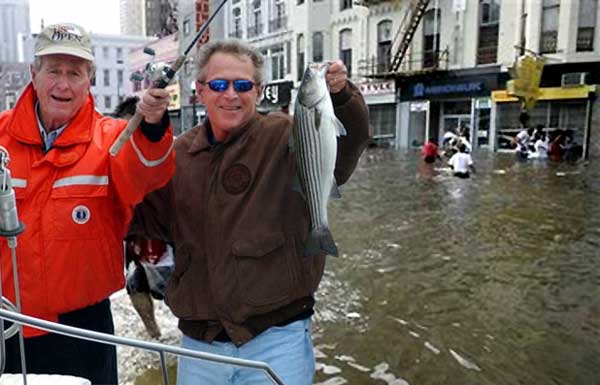
THEY RETURNED
THEY Took Your Jobs
THEY Took Your Homes
THEY Took Your Money
THEY Started Illegal Wars
THEY Destroyed the Economy
THEY Put Martha Stewart & Tommy Chong In Jail
and... THEY
Held the Teachers Accountable!
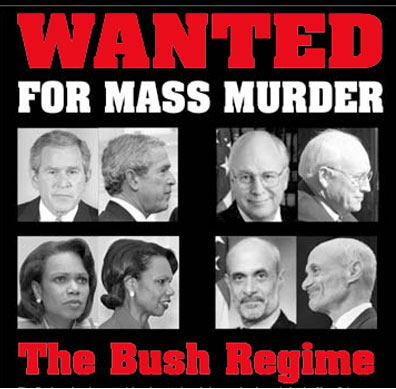
This EVIL
good ol' boy network
Brought Disgrace to the United States
with Republican, Democrat, Senate, Congress, Supreme Court Approval,
AND WALK FREE TODAY.
George Carlin - The Owners of America

Nobody Brought Peace To Our Times
"None of the Above" Should Be On Voter Ballots
GWAR - "School's Out"
TSA Diaper Operatives Allow Terrorist On Plane
Evil al bin Scorpion Stings Passenger
US man stung by scorpion on commercial flight
PORTLAND, Oregon (AP) -- All Jeff Ellis could do was wait as he sat terrified 30,000 feet (9,000 meters) in the air staring at the wriggling scorpion that stung him on a flight to Alaska.
He repeated to himself that a doctor said he'd be fine -- probably.
Ellis first had to wait 30 minutes to see whether he succumbed to anaphylactic shock.
"In the movies, scorpions kill people," Ellis, 55, said Thursday. "I was just nervous, on edge, making sure that my heart was beating normal, that I wasn't sweating."
Alaska Airlines spokeswoman Bobbie Egan said the scorpion probably crawled on board the plane during a stop in Austin, Texas. The plane then landed in Seattle, where Ellis boarded for a flight to Anchorage.
About three hours into the flight, Ellis dozed off. Then, he felt something tickling his arm.
"I felt it on my shirt-sleeve and brushed it off, I thought it was a little spider or something," Ellis said. "Then I felt it back on my elbow."
He grabbed it with his napkin and his girlfriend, Suzanne Foster, called a flight attendant, who tossed the scorpion into a clear plastic bag.
The writhing arachnid terrified children seated nearby.
"Their mother told the flight attendant, 'Get that thing out of my face,' " Ellis said.
As Ellis monitored himself for signs of a fatal allergic reaction, emergency responders in Anchorage were told to get ready; the flight would be landing soon.
But they had a problem, Ellis said: Scorpions aren't common in Alaska, and the EMTs didn't know what to do.
"They had to Google it," he said.
News traveled quickly through the cabin, but Ellis said no one panicked. He was the first to get off the plane, he said, where he was met by a police officer.
In the end, it turned out that the doctor on the flight was right. Ellis was OK, and all that's left of the incident is a mark on his arm.
Egan said the airline has never had a poisonous creature on one of its flights before, but it wasn't the first time someone found a scorpion on a plane.
During a Southwest Airlines flight in 2009, an Arizona man was stung while traveling from Phoenix to Indianapolis. His 10-year-old son found the rest of the family of scorpions in the luggage compartment over their seats.
Ellis thinks -- based on photos he took of the eight-legged pest -- that he was stung by a striped bark scorpion, which is common in Texas.
He said he is happy with the flight crew's response, and said the airline has offered him 4,000 frequent-flier miles and two round-trip tickets.
His return flight to Seattle, he said, was uneventful.
Keith Olbermann - Fire TSA Head Diaper Operative, John Pistole
Fire TSA Diaper Head John Pistole - Keith Olbermann's recent "Worst Person in the World."
Mike Wilhelm with the FLAMIN' GROOVIES - River Deep Mountain High (Live Berlin 1980)
Bioregionalism (a definition)
From: Peter Berg
Date: 25 Apr 2002, Article Source: http://www.diggers.org/freecitynews/_disc1/00000017.htm
By Peter Berg
[Peter Berg coined the term "bioregionalism" in the early 70s to define an environmental perspective that emphasizes action over protest, lifestyle over legislation. Here he brings us up to date on the definition as it currently is being acted out on the stage of the ecology crisis we all must confront. The original publication is located at http://www.planetdrum.org/.]
The catastrophic effects on Earth’s biosphere due to human activities since the inception of the industrial era have become imperiling to all life. A transformation of fundamental aspects of consciousness is urgently required to halt and reverse this destructive process. Conservation of resources and environmentalism alone are not adequate to the task. The concept of a bioregion as the basic location where people live, and the practice of reinhabitation of that life-place by its residents, are necessary to rejoin human beings into the overall web of life. Harmonizing with the natural systems of each bioregion is a necessary step toward preserving the whole biosphere.
A bioregion is defined in terms of the unique overall pattern of natural characteristics that are found in a specific place. The main features are generally found throughout a continuous geographic terrain and include a particular climate, local aspects of seasons, landforms, watersheds, soils, and native plants and animals. People are also counted as an integral aspect of a place’s life, as can be seen in the ecologically adaptive cultures of early inhabitants, and in the activities of present day reinhabitants who attempt to harmonize in a sustainable way with the place where they live.
Because it is a cultural idea, the description of a specific bioregion is drawn using information from not only the natural sciences but also many other sources. It is a geographic terrain and a terrain of consciousness. Anthropological studies, historical accounts, social developments, customs, traditions, and arts can all play a part. Bioregionalism utilizes them to accomplish three main goals: 1) restore and maintain local natural systems; 2) practice sustainable ways to satisfy basic human needs such as food, water, energy, housing, and materials; and 3) support the work of reinhabitation. The latter is accomplished through proactive projects, employment and education, as well as by engaging in protests against the destruction of natural elements in a life-place.
Bioregional goals play out in a spectrum of different ways for different places. In North America, for example, restoring native prairie grasses is a basic ecosystem-rebuilding activity for reinhabitants of the Kansas Area Watershed Bioregion in the Midwest, whereas bringing back salmon runs has a high priority for Shasta Bioregion in northern California. Using biomass as a renewable energy source fits Cascadia Bioregion in the rainy Pacific Northwest. Less cloudy skies in the Southwest’s sparsely vegetated Sonoran Desert Bioregion make direct solar energy a more plentiful alternative there. Education about local natural characteristics and conditions varies diversely from place to place, along with bioregionally significant social and political issues
In the early 1970s, the contemporary vision of bioregionalism began to be formed through collaboration between natural scientists, social and environmental activists, artists and writers, community leaders, and back-to-the-landers who worked directly with natural resources. They wanted to do “more than just save what’s left” in regard to nature, wildness and the biosphere. Planet Drum Foundation in San Francisco became a voice for this sentiment through its publications about applying place-based ideas to environmental practices, society, cultural expressions, philosophy, politics, and other subjects. By the late 70s, bioregional organizations such as the Frisco Bay Mussel Group in northern California and Ozark Area Community Congress on the Kansas-Missouri border were founded to articulate local economic, social, political, and cultural agendas. The Mussel Group eventually played a pivotal role in persuading the public to vote down a bioregionally lethal Peripheral Canal proposal to divert fresh water away from San Francisco Bay. The Ozarks group has held continuous annual gatherings to promote and support place-based activities. At present there are hundreds of similar groups (and publications) in North and South America, Europe, Japan, and Australia.
There is a strong affinity for bioregional thinking in many fields that relate to ecological sustainability. Restoration ecology practitioners readily grasp the importance of an appreciative local culture for their efforts to revive native plants and animals. Urban ecology advocates use bioregions for “nesting” their redesigned cities in a broad natural context. Permaculturalists and most organic farmers employ techniques that are appropriate to their particular locales and insist on maintaining soils, water sources, and native species. Poets, painters, theater groups, and other artists have embraced bioregional themes in their works. Grade school teachers introduce bioregional concepts, and graduate schools recognize theses and dissertations based on them. Followers of Deep Ecology claim bioregionalists as a social manifestation of their biocentric philosophy. Even traditional conservation and environmental groups including the Sierra Club have subsequent to the inception of bioregionalism adopted a system of “ecoregions” to address members’ problems in home areas.
Bioregionalists are primarily concerned with their own local areas. There are a surprisingly large number of opportunities to address everyday living conditions for the benefit of local sustainability; as wide-ranging as resident-based reforestation projects in rural areas and community gardens in cities. Their influence is felt most strongly on county and city levels because this is where they take place and are most visible. Watershed-based organizations with bioregional priorities for basins as small as a creek or as large as the Great Lakes are a steadily growing phenomenon. Their recommendations to boards, councils, and other agencies aren’t limited to creek restoration, water conservation, and other obvious issues, but may also include redrawing political borders to fit watershed lines and adopting ecological urban plans.
On a broader level, representatives of the bioregional movement from far- flung places have held gatherings and congresses in Canada, Italy, Mexico, and the US that resulted in the formulation of general principles and statements of intent like the often-reprinted proclamation “Welcome Home”. The defense of bioregions from globalist intrusions is a persistent issue that requires especially creative responses. When the town of Tepoztlan in Mexico was threatened with loss of traditional water rights and political autonomy by multinational land developers, bioregionalists from throughout North America assisted in mounting a resistance that was eventually approved by the Mexican government. Most recently, the destructive ecological impact and official “greenwashing” of the 2002 Winter Olympics in Salt Lake Bioregion was investigated and successfully exposed to international media coverage through Guard Fox Watch, a monitoring group made up of bioregional activists from Japan and the US. More bioregional alliances to defend particularly threatened places can be expected in the future.
Bioregionalism
From Wikipedia, the free encyclopedia: http://en.wikipedia.org/wiki/Bioregionalism
Bioregionalism is a political, cultural, and environmental system or set of views based on naturally defined areas called bioregions, or ecoregions. Bioregions are defined through physical and environmental features, including watershed boundaries and soil and terrain characteristics. Bioregionalism stresses that the determination of a bioregion is also a cultural phenomenon, and emphasizes local populations, knowledge, and solutions.
Bioregionalism is a concept that goes beyond national boundaries - an example is the concept of Cascadia, a region that is considered to consist of the western halves of Oregon and Washington, the Alaska Panhandle, the far north of California and the West Coast of Canada. A 2010 article described how while the Vancouver Olympics of 2010 were billed as a Canadian event, in truth they were more of a Cascadian event as the coast of British Columbia shares more in common culturally with Seattle and Portland in many ways than it does with cities further east in Canada such as Calgary and Montreal.
The campfire is the new dinner party
In these austere times, the campfire is the perfect answer – and it's more egalitarian too
Matthew de Abaitua, guardian.co.uk, Wednesday 13 July 2011 20.01 BST, Article history, Article Source

The campfire brings families together, the dinner party drives them apart. Photograph: Darrin Klimek/Getty Images
I spent Saturday night at an event the host introduced as a "recession barbecue". People camped in the garden to save on babysitter and taxi costs. We all brought food and took turns at the grill to cook it. At midnight, I set a campfire. As the guests came and went around it, I realised that, in times of austerity, the campfire should replace the dinner party as the default social event.
The dinner party has become contemptible; as a progressive force in British society it was corrupted by the smug consensus of the long boom, an enabler of the addiction to house price blather and renovation chat. Status anxiety and the fraught relationship with our houses created by the asset boom means the dinner table no longer holds the promise of bringing people together. It only sets them at one another's throats, which the success of Come Dine With Me demonstrates; it is dinner party restaged as trial.
Better to gather around the egalitarian campfire. Teddy Roosevelt, America's camping president, relished his campfire chats with naturalist John Muir. Over two fat steaks grilled on the fire, Muir persuaded Roosevelt to protect the sequoia trees of Yosemite Park. And Thomas Edison and Henry Ford regularly sat together around the campfire discussing the matters of the day.
Because it belongs to no one, the campfire belongs to everyone. Each of us takes our turn to stoke it, kick some life into it, or, when it smokes noxiously in choking gusts that seem to follow us everywhere, snatch up a tray and fan it until the fire erupts from its every pore. There is no need to take guests on a tour of the campfire, nor is it beholden on them to praise your choice of fire, or inquire after the number of the man who set it for you.
Children enjoy the spectral thrill of the campfire. Playing outdoors ensures healthy tiredness and, as their bed is a nearby tent, there is no worry about getting home on time for the babysitter, nor debate about who is or is not drinking. The campfire brings families together, the dinner party drives them apart.
The late Joe Strummer was a campfire laureate. At Glastonbury, he would set a fire and keep it burning for five days. Everyone was welcome, and in its flickering light, all were equal. He also set campfires around the back of his home in Somerset and was in the vanguard of the anti-dinner party set.
Julien Temple's documentary commemorating Strummer spins recollections of the great man around the image of the campfire. "He once said to me that he thought the campfire was a better idea than any of the music he had ever made," Temple said at the Sundance film festival.
Around the fire, there is greater possibility, and risk. From out of the gloom, strangers emerge and take their seats, whereas the dinner party is fixed, the seating planned. "[The] campfire's . . . a hard place to be," said Temple. "You have to be strong enough to get out of it, and lose your worldly bullshit."
Campfire society is intense, and Strummer's version came with a punishing regime of intoxication. The atmosphere could get leery as the campfire stumbled on towards dawn. While I dispute that any useful conversation has ever taken place at four in the morning, Strummer was right that, around the fire, the classes and social types mix.
Anthropologist Richard Wrangham, in his book Catching Fire: How Cooking Made Us Human, expained how campfires coaxed us out of the trees and on to the ground, to sleep together rather than apart. We are descended from the people who could sit quietly around the fire and share cooked food, what Wrangham calls: "The coalition of the calm." I find the image reassuring; a considered gathering of wisdom rather than the braying competitive debate of the dinner party.
At the recession barbecue, the gathering grew silent. Contemplation of the fire filled us. The hairs on my calves swayed and curled in the heat like the tendrils of an anemone. I was content.
• For camping recipes from Matthew and his wife, go to their website Cath and Math go camping.
US solution to oil crisis simulation: drill more
Former White House officials take part in Oil ShockWave war game to determine US response to a terrorist attack on Saudi oil supplies
Suzanne Goldenberg, US environment correspondent, guardian.co.uk, Thursday 14 July 2011 12.12 BST, Article history, Article Source
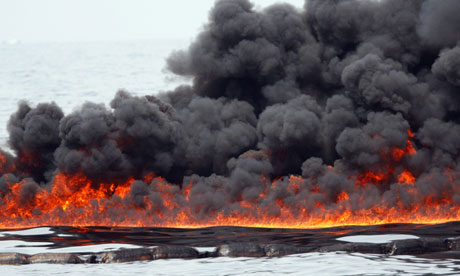
Oil burning in the Gulf of Mexico, 2010. Oil ShockWave focuses on when the
US should tap
emergency reserves. Photograph: Ann Heisenfelt/EPA
November 17, 2011: A helicopter gunship attack, possibly by al-Qaida militants, has disabled the world's largest crude processing facility in Saudi Arabia, turning the sky a bright fiery orange and knocking out a significant chunk of global oil supply.
In Washington, the national security team assembles to advise the president on how best to reassure the public and stop the US sliding back into recession. Their solution? Drill more American oil.
One month on, the crisis intensifies. Iran and Venezuela threaten to choke off oil supplies, pushing oil prices to $200 a barrel. The reaction once again: drill more American oil.
Oil ShockWave, a crisis war game, which took place on Wednesday in the Ritz-Carlton ballroom about a mile from the real White House, included George Bush's former national security adviser, a former Carter administration official and former Shell chief executive . Playing fictional cabinet officials, they acknowledged America had become hostage to its need for oil – and yet they couldn't quite seem to break away.
"We are reaping the harvest of our dependence on petroleum and the fact that the countries that produce it are either unstable or hostile to our interests," lamented Stephen Hadley, who reprised his real-life role as Bush's national security adviser. "How did we let this happen when we've known we've been dependent on oil for 20 years?"
As the scenario played out in front of over-sized monitors tuned to a fictional cable news network, the answer became abundantly clear.
The war games, sponsored by a campaign group, Securing America's Energy Future, have become a Washington fixture.
None of the participants were briefed on the war games in advance, the organisers said.
It staged the first simulation in 2005, hoping to push the White House and Congress to take strong action on energy reform. The group, which has links to Fed-Ex, is pushing for electrification of vehicles but also expanded US oil production in the short-term.
As the war gamers repeatedly noted, American leaders have been talking about weaning the nation off oil since the days of Richard Nixon.
"We have met the enemy and he is us," said Susan Schwab, a US trade representative under Bush who played an economic adviser for the war games.
Stuart Eizenstat, a former Carter and Clinton administration official who was playing treasury secretary, said he felt like he was in a bad reality show.
Immediately after the first shock, the attack on the fictional refinery, security and economic concerns crowded out ideas of moving beyond oil. Was Iran involved? Was this just the first of a run of attacks? Would America need to dip into its strategic reserves?
The fictional energy secretary, played by the former Shell chief executive, John Hofmeister, gave assurances about US domestic supply. Nobody called for an accelerated transition to renewable energies. Nobody mentioned climate change.
"The most powerful message that we have is that the United States of America has more oil than any other country in the world that we know of. We have simply been holding ourselves back from producing that oil," said Hofmeister. "I think it is time to really get the message to Congress that it is time to start producing."
Schwab thought the answer was importing more oil from Canada's tar sands.
Hadley split the difference. "Medium term, there is oil. We need to get it out of the ground. Longer term we need to diversify," he said.
But the escalating crisis, with the threats from Iran and Venezuela, forced a rethink. Without bold action, the president – who was not named for the exercise - would lose the next election, warned Ari Fleischer, who served as White House press secretary under Bush. [Ari Fleischer Lied to the People of the United States and walks free.]
"The president has to do something bold. He has a real challenge to his leadership," Fleischer said.
"He either has to announce we are going to open up America to take every tract of land that was previously closed and open it up for drilling, or make America green and go in the direction of wind and solar," he said. "Anything else is just doodling in the margins of history. We need to put the president on track for something big."
In the end, however, Hadley opted for mid-size, or both, as he called it: open up new areas for oil drilling and promote new fuel saving technologies like electric cars. Doing both things at once could count as boldness, Hadley reasoned.
As a strategy it seemed suspiciously close to that Barack Obama has pursued for the last year or so: pushing for renewable energy, but steadily opening up new areas for drilling.
But would that work in an actual moment of crisis? Almost certainly not, Fleischer admitted afterwards. "Going for the middle won't work from the communications point of view. It doesn't motivate," he said. Crises require bold inspiring measures.
So where did that leave Obama, in a tough place admittedly, but not facing a cut-off in the global oil supply. Was this the right time to go bold and go green?
Not yet, said Fleischer. That would have to wait for a full-fledged crisis. Until then, Obama would have to continue his balancing act - and Fleischer didn't rate his prospects. "I think a lot of environmental issues are like religion. People have faith in their solution and they won't move in the other direction."
Democrats were unlikely to ever be enthusiastic about Obama's plans to open up new areas for drilling. As for Fleischer's fellow Republicans, he said: "I just don't think they are going to go for a solution that involves government."
Why hacker group LulzSec went on the attack
LulzSec gained instant notoriety by targeting the CIA, multi-nationals and government websites. Then, at the height of its popularity, it disbanded. One of its founders tells why
Ryan Gallagher, guardian.co.uk, Thursday 14 July 2011 20.30 BST, Article history, Article Source
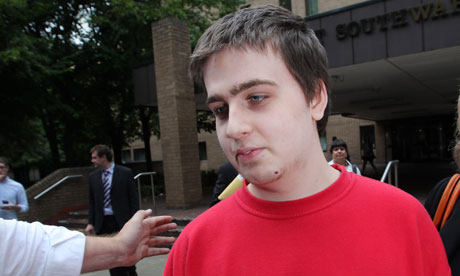
Ryan Cleary outside Southwark crown court where he was charged under
the
Computer Misuse Act. Photograph: Peter Macdiarmid/Getty Images
Its audacity was brazen and apparently fearless. Among its high-profile victims were Sony, the CIA, the FBI, the US Senate and even the UK's Serious Organised Crime Agency. Exposing frailties in government and corporate networks, the group leaked hundreds of thousands of hacked passwords, and in the process garnered more than a quarter of a million followers on Twitter. But after just 50 days, on 25 June, LulzSec suddenly said it was disbanding.
Just hours before this announcement, the Guardian had published leaked internet chat logs revealing the inner workings of the group, which appeared to consist of six to eight members. The logs showed that authorities were often hot on their heels, and that after an attack on an FBI-affiliated website two hackers had quit LulzSec as they were "not up for the heat". As media attention mounted, Ryan Cleary, an Essex-based 19-year-old suspected of affiliation to LulzSec, was arrested in a joint UK-US "e-crime" investigation. Had the pressure simply got too much to handle?

'High-quality entertainment at your expense' . . . the LulzSec logo
To find out, the Guardian tracked down one of LulzSec's founding members, "Topiary". A key figure in the tight-knit group, he was revealed in the logs to have managed LulzSec's Twitter account and to have written their press releases. After verifying his identity by asking him to send a direct message from the account – "This is the captain of the Lulz Boat," he confirmed – we began a long conversation by Skype.
"I know people won't believe this, but we genuinely ended it [LulzSec] because it was classy," he says. "The leaks we promised happened . . . 50 days were reached, we just about hit 275,000 Twitter followers, things were on a high, so we redirected our fans to [hacker collective] Anonymous and [hacking movement] AntiSec and wrapped it up neatly . . . A high note, a classy ending, a big bang, then a sail into the distance."
LulzSec's jovial public image undoubtedly helped it achieve unusual popularity within a short time. Its stated aim was to provide "high-quality entertainment at your expense," and the word "Lulz" is itself internet slang for laughs. The group's popularity spiked after it planted a fake story on US news outlet PBS.com in protest over what it claimed was a misrepresentative WikiLeaks documentary made by the broadcaster. The story falsely reported that rapper Tupac Shakur, who was killed in a shooting 15 years ago, had been found alive and well in New Zealand.
"What we did was different from other hacking groups," says Topiary. "We had an active Twitter (controlled by me), cute cats in deface messages, and a generally playful, cartoon-like aura to our operations. We knew when to start, we knew when to stop, and most of all we knew how to have fun."
But the group's mission, Topiary explains, was not calculated. Almost everything LulzSec did – from choosing its name to its next target – happened spontaneously. "We made it up as we went along. We were originally @LulzLeaks on twitter, but I forgot the password so we became @LulzSec. My first name was The Lulz Train, then The Lulz Cannon, then The Lulz Boat. I had no idea what The Love Boat was, it was a complete accident . . . I wrote every press release in Notepad without planning. That's what made us unique, we just came out and made stuff up out of nowhere . . . We released when it felt right, we tweeted what felt right, we wrote what we felt needed to be wrote. We weren't burdened by plans or board meetings, we just did it."
The leaked chat logs also revealed the hackers appeared to revel in the international attention they received. However, Topiary says it wasn't that LulzSec was media-hungry, but that the media was LulzSec-hungry.
"We didn't contact a single media outlet for at least the first 40 days, they just kept reporting on our humble tweets," he says, though he admits the attention "gave us more reasons to leak more. It was a thrill, sure, and it did play a role. We enjoyed occasionally confusing and pranking media with weird tweets, or giving exclusives to certain journalists to piss off other certain journalists. It was another aspect of the situation that helped us leverage the entertainment."
Yet although many of LulzSec's attacks were perpetrated "for the lulz", the group was accused of attempted extortion by one US security company, Unveillance – a charge Topiary staunchly denies. It was also criticised after it hacked and dumped thousands of Sony Pictures Europe customers' usernames and passwords online, some of which were reportedly later used in scams by fraudsters. But Topiary is unapologetic.
"It's Sony's fault for not defending – and encrypting – its customers' data," he says. "Similarly, in a perfect world, we'd have dumped said data and nothing would have happened. These scams simply prove that other people (our fans/spectators) are more evil than us."
Towards the end of LulzSec's reign, it seemed to gravitate towards more overtly political causes. It occasionally compared itself to WikiLeaks in tweets, and its penultimate leak was a joint effort with Anonymous to expose Arizona police as "racist and corrupt", and to "sabotage their efforts to terrorise communities fighting an unjust 'war on drugs'."
Anonymous is well known for its acts of political "hacktivism". On Monday it reportedly threatened to attack the Metropolitan police over News International's phone hacking and the possible extradition to Sweden of WikiLeaks founder Julian Assange. Earlier this year the group claimed responsibility for a series of Distributed Denial of Service (DDoS) attacks on government websites in Tunisia, Iran, Egypt and Bahrain, and in 2008 it attacked the Church of Scientology after it allegedly attempted to suppress a leaked video interview with actor and scientologist Tom Cruise. Topiary has been heavily involved with Anonymous in the past, occasionally acting as its spokesman in televised interviews.
"Anonymous has been a great way for the younger generations to get involved through methods they understand, like utilising the internet," he says. "My main goal with Anonymous was to spread the word of revolution to those who might be seeking something new."
How does he define revolution? "Revolution is kicking the Tunisian government in the teeth by rendering their malicious Javascript embedments inert, allowing Tunisian citizens to surf Facebook without fear of password sniffing. Revolution is a horde of activists holding up Anonymous masks and thanking us for assisting their hard work by obliterating their government's ministry, stock and finance websites, replacing them with inspiring words. Revolution, to me, is bringing down the big guy while not forgetting to stand up for the little guy."
Though Topiary will not disclose his age, he describes himself as a teenager and "an internet denizen with a passion for change". He believes he is part of a generational shift in the way technology – specifically the internet – is increasingly being used as a tool to influence the world. The actions of Anonymous in particular, he says, have brought attention to the idea that actions taken online can have a major impact in real life – "linking the two realities". But he also recognises that the actions of Anonymous, LulzSec and other affiliated hackers can be used by governments as justification for greater control of the internet. So how does he balance his actions with that knowledge?
"It only results in greater government control if we remain apathetic and let it happen," he says. "The goal with Anonymous is to brutally cut down the middle of that decision and shout 'NO' to laws we don't agree with. Laws are to be respected when they're fair, not obeyed without question."
For now, however, Topiary is taking a break from law-breaking. He says he will continue operating on the margins of Anonymous, but will not engage in any more hacking. Instead, he intends to create art, video and graphics for the group to help with a new public relations project, to be titled Voice.
"I've been at this non-stop for a while, it's a big time-sink," he says. "Some people can handle it for years on end, and I respect those people. I just needed some air and a new page in the Anonymous/LulzSec era."
After the arrest of Cleary last month, suspected US hackers believed to be affiliated with LulzSec had their homes raided in Ohio and Iowa. In the past, hackers have been offered immunity from prosecution if they cooperate with the authorities. But, if caught, Topiary says he would "never snitch" on other hackers and that he would "pretty much" rather go to jail than work for the government in any capacity.
"Not sure I'd have a place in government security, unless they enjoy bizarre tweets," he says. "But again, no, I wouldn't accept a job that would fight against the things I've fought for. As for the authorities, well, if they have their claws in, they have their claws in, there's not much I can do about it. But I can only hope that they haven't pinned any of us, especially my friends from LulzSec."
Hitler rants about Carmageddon via Fred
Two Tibetan Folk Songs
Final Countdown - Concert in Kipsala hall with the Symphonic orchestra of Liepaja and melo-m (3 cellos)
Israeli spy claims over Christchurch earthquake
New Zealand prime minister confirms, but then plays down, investigation over Israeli victim said to have held five passports
Toby Manhire in Auckland, guardian.co.uk, Wednesday 20 July 2011 09.15 BST, Article history, Article Source

A New Zealand newspaper has suggested an Israeli spy was one of the victims
of the Christchurch earthquake. Photograph: Martin Hunter/Associated Press
New Zealand intelligence services launched an investigation into a possible Israeli spy operation in Christchurch after suspicious activity was observed in the immediate aftermath of the February earthquake, the New Zealand prime minister, John Key, has confirmed.
But Key insisted the investigation had been completed with no evidence found of wrongdoing.
Inquiries centred on a potential breach of the national police computer system.
According to a report in the Southland Times, the investigation was prompted by the departure from New Zealand of three Israeli citizens within hours of the 22 February quake and the discovery of as many as five passports on one of three Israelis killed.
There were reports of an unauthorised Israeli search and rescue team that was refused entry to Christchurch's cordoned-off central business district.
There was widespread speculation in New Zealand that the country could be facing asequel to the events of 2004, when Helen Clark's government imposed diplomatic sanctions on Israel after two suspected Mossad agents were convicted of passport fraud in Auckland. The Israeli government apologised the following year.
The prime minister, who is visiting the US, initially did little to dampen suggestions of another diplomatic imbroglio when he evaded reporters' questions, insisting "it is not in the national interest to discuss those matters", while confirming he had taken "a number of calls" from the Israeli premier, Binyamin Netanyahu, in the hours after the Christchurch earthquake.
Later in the day Key moved to dismiss spying claims. In a statement he said the investigation had been concluded and there was no evidence of subterfuge. "Security agencies conducted the investigation and found no evidence that the people were anything other than backpackers."
Key said he had been advised that reports of Israeli citizens carrying multiple passports were ill-founded and he was satisfied with police assurances that there had been no unauthorised access to the police computer system.
"The investigations that have been undertaken have been thorough and have found no evidence of a link between the group and Israeli intelligence."
The author of the Southland Times article, Fred Tulett, stood by his story, saying that contrary to Key's remarks the investigation was continuing. He maintained that five passports had been in the possession of the Israeli who was killed, Benyamin Mizrahi.
Key said the man was found with a European passport. His companions handed over a second passport, his Israeli one, when they left the country.
The Israeli ambassador for the South Pacific, Shemi Tzur, said any suggestion of a Mossad presence in Christchurch was "science fiction". The Israeli citizens had returned home following the death of a friend whose van was crushed, he said.
The Israeli rescue teams, he added, were refused entry because they lacked the necessary authorisation but were there for the right reasons and were left "angry and upset".
He told the Southland Times: "Yes, there was some regrettable history of Mossad involvement in New Zealand in 2004, and they have apologised for that and we have put it beyond us. Now we are moving forward."
Coverup Breaking in Saudi Role in 9-11
Executive Intelligence Review PRESS RELEASE
July 12, 2011 (EIRNS)—With the tenth anniversary of the 9/11 attacks just two months away, the Saudi role in the events of Sept. 11, 2001 are back in the headlines. On July 11, former Sen. Bob Graham (D-Fla.), who co-chaired the Congressional probe of the 9/11 attacks, appeared on the Morning Joe show and tore into the Saudis' involvement, citing Prince Bandar and the BAE bribes, and the role of Saudi Royals in supporting the attacks. Graham has recently written a novel, based on the 9/11 attacks.
The current newsstand issue of Vanity Fair magazine has a lengthy article, "The Kingdom and the Towers," by Anthony Summers and Lynne Swan, documenting the role of a number of members of the Saudi Royal Family in bankrolling al-Qaeda and the 9/11 hijackers. The article is based on a book by the husband and wife team that is scheduled to appear later this month in the United States, providing a comprehensive account of the 9/11 attacks, with heavy emphasis on the Saudi Royal Family complicity, and the Bush White House coverup.
Much of the material in the Vanity Fair article will be familiar to EIR readers, including the role of two Saudi intelligence officers, Basnan and al-Bayoumi, who facilitated two of the 9/11 hijackers' efforts from the moment they arrived in Los Angeles in 2000. They were also recipients of BAE funds laundered through Prince Bandar's Washington bank accounts.
The article made clear that other leading members of the Saudi Royal Family, including the current Interior Minister, Prince Naef, and Bandar's father, Prince Sultan, were also complicit in the funding of al-Qaeda, from no later than 1997. The 28-page segment of the Congressional 9/11 study that was censored by the Bush White House and has been kept secret to this day, detailed the trail of Saudi Royal Family funds to the 9/11 hijackers. - Re-thinking 9/11
Guitar Oscillations Captured with iPhone 4
Designer Kyle Jones accidentally captured what appear to be oscillating guitar strings when he placed his iPhone 4 inside his guitar and recorded a video of himself playing. After he posted the video on Reddit, a vigorous debate erupted between experts big and small as to the exact nature of the effect. Many commenters have pointed to the iPhone camera’s rolling shutter, which can produce curious effects when capturing fast motion. - Source via Hal
Reverend Billy leads exorcism of BP's 'evil spirit' from Tate Modern
The comic preacher and his Earthalujah gospel choir stage a 'service' in protest over oil giant's sponsorship of art gallery
It's 5.30pm on Monday, and as the crowds in the massive turbine hall at the Tate Modern thin out, a neat young man with slicked back hair quietly disrobes, revealing a white suit. Eight others approach him, donning green costumes. No one bats an eyelid – until the man starts singing a gospel song.
What few people at the Tate know is that is the Reverend Billy and his Earthalujah gospel choir. They are in London to exorcise the "evil spirit" of BP from the Tate, one of the main sponsors of the art gallery. Billy is a part-theatre, part-evangelical Christian, part-US performance artist. He founded the church of Earthallujah following BP's spill in the Gulf of Mexico last year after years of using fundamentalism to parody US consumerism.
He's a cross between Elvis and preacher Billy Graham, and soon the Tate balconies are full, and a crowd of 50 is on its knees around him, spontaneously raising their their hands, holding each other, whooping, singing and amen-ing. Bottles of thick black oil are poured over Billy, he smears himself across a BP logo and whips himself and his congregation into a frenzy of irony.
Ten minutes later, with a few policemen and Tate flunkies squirming at yet another art performance mounted against the continuing sponsorship of the arts by the oil company, Billy leads his new congregation outside. He could probably dunk them in the Thames, so willing are they to follow him, but instead he rails on the lawn against corporate exploiters and polluters, consigning them to the "lake of hellfire".
BP uses art sponsorship, he says, to give it a social licence to operate. The groups Liberate Tate, UK Tar Sands Network, London Rising Tide, Art Not Oil and Climate Rush, who together brought the Rev Billy to the Tate, say BP uses the "fair face of the arts to mask the stench of its true nature".
Judging from the crowds applauding his similar performances in Liverpool, Holland and at festivals in Britain over the last few weeks, the art establishment is losing the war against the growing movement by activists. In the last year, black balloons filled with oil have been released in the Tate, there have been impromptu performances at the National Theatre, Trafalgar Square and elsewhere. What to BP, Shell and the art establishment was, to begin with a mild irritant, is in danger of becoming an open wound. Lord Coe has said that the Gulf of Mexico oil spill will not harm BP's sponsorship of the 2012 Games but in these febrile times, that may be be in doubt.
For Billy, a child of Dutch calvinists who says he is "in full flight from fundamentalism", corporate commercialism is the real devil, and the line between art and irony, and religion and belief in nature is fine. Environmentalism may be widely accused by the right wing of becoming a religion yet it is the American, God-fearing right which mostly denies climate change.
"We are a post-religious church. We hold 'services' wherever we can, in concert halls, theatres, churches, and community centres," says Billy. "People who dress like me are the ones causing climate change. They are the homophobic supporters of war. In the US they get angry [with me]. They make comparisons between me and the devil. But people raised on irony have a challenge too. We marry people, baptise people, and are present at funerals. After 9/11 the parody went away. We want now to hold hands and pray?
"We are all in full flight from fundamentalism. The corporate culture is truly the heaviest, the most fundamentalist in the US. Its more serious than the church in the 14th century." - Source
If it really wants to cut carbon, why is the coalition issuing licences to drill?
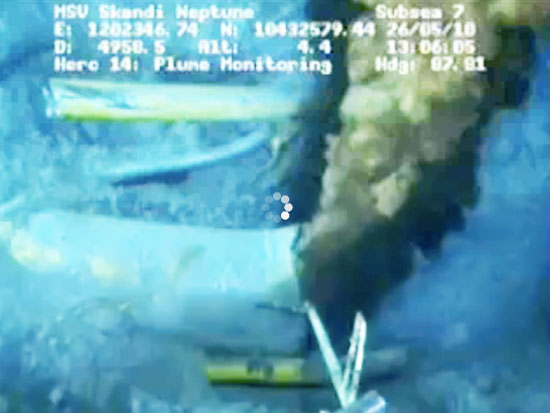
BP Oil Cam - Gulf Oil Spill
Pledges to curb reliance on fossil fuels are hard to square with prospecting for more oil and gas and pushing dirty coal plants
George Monbiot, guardian.co.uk, Monday 18 July 2011 21.00 BST, Article history, Article Source
Rejoice, the boom is back! After a drought of investment, last week BP announced that it was spending £3bn to redevelop fields in the deep waters to the west of Shetland. The government was delighted: this shows, it says, that its policies are working. It promised to "continue to work alongside oil and gas companies to support growth and jobs in the UK".
Great. But hold on a minute, didn't the government tell us, just two days before, that its priority is to decarbonise the economy? Well it depends who you're talking to, and at which point in the cycle of crashing contradictions you catch them.
Let me give you a few examples of joined-up government. In January, Chris Huhne, the secretary of state for energy and climate change, reminded us that "a shift towards non-fossil fuels is in our long-term national interest, as well as the interests of the planet". The following month his deputy, Charles Hendry, travelled to the International Energy Forum in Riyadh to beg Saudi Arabia to increase the supply of oil.
At the end of June Huhne told us that "the coalition is determined to reduce our reliance on fossil fuels". Five days later, the Treasury expanded the tax breaks for companies prospecting for new oil and gas reserves. With Brent crude at a mere $118 a barrel, the poor dears need all the help they can get. Last week, in its white paper on electricity planning, the government called for steep reductions in energy demand. In the same document it proposed "maximising the economic recovery of our remaining indigenous resources of oil and gas by launching a new offshore licensing round in 2012".
What we don't understand, the government tells us, is that new oil and gas extraction is a "transitional investment". As Hendry explained in October, "whilst in the long term we want to decarbonise our energy system, we have moved swiftly to offer these licences" for new oil and gas. This investment is transitional in the sense that switching from 20 cigarettes a day to 40 is a step towards giving up.
Labour also encouraged companies to extract as much fossil fuel as possible while imploring us not to use it. In fact, with the exceptions of Saudi Arabia and Ecuador, all the governments sitting on reserves are seeking to maximise production while most also claim to be minimising consumption.
So you could be forgiven for believing that governments aren't serious about climate change. There would be no clearer statement of an intent to prevent climate breakdown than declaring part of our fossil fuel reserve off-limits in perpetuity: a kind of underground national park. There is no clearer statement of an intent to fiddle while the world burns than to keep pushing up supply while trying to reduce demand.
We now have a clearer idea of how big the underground park would have to be. A new report by the Carbon Tracker Initiative seeks to discover how much of the global fossil fuel reserve could be burned without committing us to 2C of global warming. Before discussing the figures, let me remind you of the difference between reserves and resources. A resource is the total quantity of a mineral found in the earth's crust. A reserve is the fraction of the resource which has been identified, quantified and is cost-effective to exploit.
Researchers at the Potsdam Institute in Germany estimate that, to keep the chances of exceeding 2C to 20% or less, between 2000 and 2050 the world can afford to release no more than 886bn tonnes of carbon dioxide. As we produced 321bn tonnes between 2000 and 2010, that leaves only 565bn for the next 40 years.
But if current fossil fuel reserves were all extracted and burned they would produce some 2,795bn tonnes: five times as much. (These figures, being averages, suggest a precision that no one intends.) About 40% of the CO2 produced this century will remain in the atmosphere until at least the year 3000. This means that current reserves contain roughly twice as much carbon as we can afford to burn in the millennium. In a world that took climate change seriously, most fossil fuel reserves would be worthless.
The government claims it can resolve this contradiction through carbon capture and storage (CCS): trapping CO2 produced by burning fossil fuels and piping it into underground stores. But much of the fuel that companies intend to extract will be burned in cars, planes or domestic boilers, from which the emissions cannot be captured. Even the promise of CCS in power stations relies on technologies which have not yet been proven in combination, at scale. To pin so great a hope on so uncertain a prospect suggests we have learned nothing from the magical thinking that caused the financial crisis.
In fact, reading last week's white paper, it looks as if the primary purpose of CCS is not to prevent climate change but to permit the construction of a new generation of coal plants. The paper proposes an emissions performance standard for new electricity plants, which means a limit to the amount of carbon dioxide they can release per unit of power they produce. The limit it sets is a ridiculous 450 grams per kilowatt hour: ridiculous because this is slightly higher than the current average, which is bumped up by the creaky old coal plants built in the 1970s and 1980s.
Even so, most new coal would be hard to build to this standard as coal produces more carbon per kilowatt hour than other fossil fuels. But there's a get-out clause: if your new coal burner is a "CCS demonstration plant", it's exempted from the emissions standard. This seems, at first, incomprehensible: surely the power stations with CCS should have the lowest emissions? The purpose of the exemption, the government tells me, is "to ensure we have the flexibility to select the most appropriate demonstration projects". This elucidates precisely nothing.
But there's a likely explanation. The demonstration plants need to capture only part of their output of carbon dioxide: the gas arising from just 300 megawatts of what could be a 4,000-megawatt power station. The CCS exemption resembles nothing so much as a means of keeping polluting coal-burners in business.
All this reminds us that Rupert Murdoch's corporation is not the only one whose power subverts the purpose and priorities of government. Corporate lobbying poisons all democratic politics. The threat of climate change has so far done little to disrupt the fossil fuel companies' business plans, or their grip on policy. The assault on Murdoch's empire is just the beginning of the necessary challenge to corporate power.
Not the retiring kind
More older women than ever are becoming entrepreneurs, but is this a step forward or a generational glitch?
Amelia Hill, guardian.co.uk, Thursday 21 July 2011 20.59 BST, Article history, Article Source
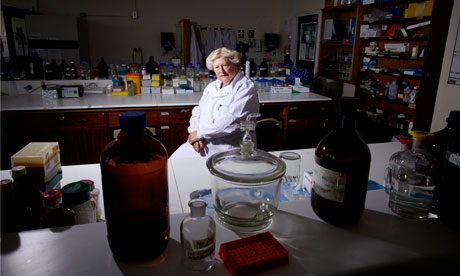
Professor Diana Anderson at the University of Bradford. Photograph: Christopher Thomond for the Guardian
At the beginning of June, Professor Diana Anderson set up her very first business: the marketing of her new invention, a blood test that predicts an individual's genetic predisposition to cancer.
After years closeted away in laboratories, universities and libraries, to be the founder and chief executive of a new company, Oncascan, is exciting for Anderson. But she is also part of a wider trend. Now that there is no longer the pressure to retire or the law to enforce it, the number of older women starting businesses is on the increase. Anderson turned 70 just a few weeks ago.
"I'm not proud to have started my first business so late in life for the simple reason that my age never occurs to me," she says. "Until I am no longer able to contribute, I only think of staying at the coalface of my profession. My future plans are to make my business a success, win more grants for my university and guide more of my students towards their PhDs."
Anderson, the chair of biomedical sciences at the University of Bradford, adds that until age "forces me to retire", she has no intention of pottering in the garden, doting on grandchildren or travelling the world. And far from being a disadvantage, she thinks her age is her greatest asset. "I am a better scientist and teacher because of my weight of experience," she says. "Even my newfound entrepreneurial streak is a direct and default result of my age: I couldn't have set up this business when I was younger because I needed all my accumulated years of knowledge to spot the idea and see the gap in the market."
According to figures from Barclays, she is not alone. Older entrepreneurs are responsible for 50% more startups than they were 10 years ago and account for 15% of all new businesses in England and Wales. And life experience does seem to give them an edge: companies started by older people have a 70% chance of surviving the crucial first five years, compared with only 28% for younger people.
It's a change that Bev Hurley, the 58-year-old director of Enterprising Women and employer of an 85-strong workforce, has noticed. "Traditionally, the age when women started up businesses was 30 to 45, but when we started running courses for female entrepreneurs in 2006, we saw an even split between younger and older women," she says. "The oldest woman we have supported was 72 years old."
Children leaving home, mortgages being paid off and redundancy payments or pensions to invest all give older women the means to match the confidence that often comes with age. According to Chris Ball, chief executive of the Age and Employment Network: "Older women entrepreneurs are very interesting. They have the confidence to realise that the experiences they have accumulated – especially the juggling involved in bringing up a family – are all enormously transferable."
Carolyn Hadden-Patten, however, believes that while age has given her a professional advantage it also brings some problems when starting companies. Hadden-Patten ran a clothing shop in the 1980s and 1990s, before retiring. But she found that she missed working so, aged 58, she set up an online magazine for older women, the Weekly Wrinkle. "I'm less able to carry stress and I get tired in the middle of the day," she says. "I worry more and am less brave: I don't sleep as well as I used to, so my mind races at night and I don't wake up refreshed and energetic."
Hadden-Patten is fortunate, however, to have the choice over when she retires. Others must plough on despite – and not regardless of – their increasing age. Hilary Farnworth, a senior lecturer at the London Metropolitan Business School's Centre for Micro-Enterprise, estimates that half of the older women are setting up businesses out of financial necessity.
"If you lose your job after the age of 50, you have a one in 10 chance of getting another," she says. "Living on £66 a week Jobseeker's Allowance plus rent isn't a happy place to be – and there are a lot of years between 50ish and 66, when you can start to claim your state pension. Older women who set up their own businesses are often those to whom life has dealt a serious blow."
Cathy White, 59, whose catering and property businesses collapsed under the weight of the credit crunch, understands this. "My husband and I had been looking forward to retirement. We were going to sit in the garden and hold hands. But just as this wonderful dream was about to become a reality, we suddenly found ourselves weeks away from bankruptcy."
Now White and her 74-year-old husband, Geoffrey, run their local branch of the national catalogue business, Kleeneze. "We dusted ourselves off and started again, and now we're working seven days a week, have 640 customers and are recruiting new staff," she says. "This is not how we wanted to spend our retirement but we're grateful the workplace is flexible enough to give us an opportunity to set up again at our age."
However, experts say flexibility – and employers' prejudice against hiring older workers – must be tackled if the economy is to survive the social revolution under way in British society. Changes in life expectancy mean that one in six people alive today will live until the age of 100. By 2030, the number of people over 50 will have increased to 27 million, or 40% of the total population. It is, says the Office of National Statistics, the most significant demographic trend affecting the size and composition of the labour force for at least the next 15 years.
But it is a highly vulnerable group. According to the Prudential insurance company, more than a third of people planning to retire this year will have incomes below the poverty line.
But the goal of achieving an 80% participation rate among this group is not just to improve their welfare. Economist Christopher Smallwood says it is "crucially important for Britain's economic future". An increase in the labour force of 800,000 – the number of people between the ages of 50 and 65 who say they want to work – would mean that instead of creating a pension and NHS timebomb, Britain's GDP would be increased by about £58bn a year. If even a third of this group returned to work, the saving would be more than £3bn a year.
And opening up the labour market to older people, especially older women, need not involve much upfront funding. "It's not a question of throwing money at it. Older women tend to set up lifestyle businesses: one person on their own. These need an average of just £8,000 to £10,000 startup funding," says Hart. But, he adds, what older women really need is confidence. "They are more likely than older men to say they don't have the skills to set up their own businesses when they actually do. They need specialist mentoring and support."
Hurley adds that older women "have particular health problems and are often facing issues such as the care of elderly parents". They are also more likely to be intimidated by the increased financial risks that come with starting a business late in life – a business which you then have only limited time to create and grow.
Even if specialist funding, advice and support is available, some fear that the older woman entrepreneur might be a historical anomaly. At 62, Patsy Seddon is on her third business startup. Seddon, who sold Phase 8, her own fashion label, in 2005 for £28m, recently launched the online fashion retailer Shircket.com. "We were 1960s children, who came of age in a time of quite extraordinary energy, optimism and possibility," she says. "It was easier to get childcare and, because we had babies when we were so young, we still had energy to throw into our professional lives when they were grown up.
"Life for women now is much more confused. Everything is happening later. Women are waiting so long to have babies that they don't want to work when it finally happens – and then they're too tired to return to work after their children have left home. It would be a great shame for women and for society, but I think there's a real risk that the older businesswoman is a wonderful but momentary glitch."
Bruce Springsteen gets poll backing to run for New Jersey governor
Bruce Springsteen was added for fun to poll's list of possible Democratic challengers to Republican incumbent Chris Christie
Ewen MacAskill in Washington, guardian.co.uk, Thursday 21 July 2011 19.36 BST, Article history, Article Source

Bruce Springsteen, a New Jersey native, has been openly critical of governor Chris Christie. Photograph: Felix Hoerhager/EPA
When Bruce Springsteen wrote Born to Run more than 30 years ago, it is a safe bet that the eventual destination he had in mind in his anthem to youthful hopes was not the governor's residence.
But a poll suggests he would romp home in a race against the Republican incumbent in New Jersey, Chris Christie.
The Public Policy Polling survey ties the two on 42% but gives Springsteen much higher favourability ratings.
The survey, conducted from 15-18 July, added Springsteen for fun to a list of possible Democratic challengers to Christie.
Although Springsteen has not indicated plans to stand, the New Jersey native is highly political, having campaigned for John Kerry and Barack Obama in the 2004 and 2008 White House elections, and has been openly critical of Christie.
The Republican governor, who was talked about as a potential Republican presidential candidate earlier this year, has seen his political fortunes dive. Christie is a big Springsteen fan, claiming to have seen him live 125 times, and asked him to perform at his inauguration as governor in 2009. Springsteen declined.
PPP, in a press release, said that if Springsteen was to stand and came across as a credible candidate, he could see a rise in the 42% recorded in the poll. "Springsteen has favourability numbers any politician would die for," PPP said.
Springsteen, who lives in New Jersey, wrote to New Jersey's Asbury Park Press earlier this year complaining about Christie's budget cuts.
"The cuts are eating away at the lower edges of the middle class, not just those already classified as in poverty, and are likely to continue to get worse."
When Springsteen refused to play at Christie's inauguration and criticised his opposition to same-sex marriages, Christie joked that it had been two bad decisions by the rock star.
"Bruce and I don't agree on certain things politically – big shock," Christie said. "But it doesn't diminish at all my enjoyment of him as an artist and a performer."
San Francisco set to require cellphone radiation warnings
Photo: An old-fashioned handset for cellphones was created as a gag gift by Yubz and retails for $45. Credit: Yubz
Are cellphone rays harmful? It seems like every few months, another study comes out weighing in on the debate. As soon as one important health organization declares phones are "possibly carcinogenic," another important-sounding medical journal pops up with a rebuttal.
Well, San Francisco isn't taking any chances. In a 10-1 vote, the city's board of supervisors passed an ordinance Tuesday that requires cellphone shops to warn customers about radiation hazards emitted by everyone's favorite pocket companion.
Specifically, retailers will be expected to post general warnings about potential radiation risks and ways to lower the amount of radiation exposure to people's bodies.
If this sounds like deja vu, you're right. Last year, the board passed a similar ordinance requiring cellphone shops to post info on each product's "specific absorption rate." Known as SAR values, it's a dire-sounding reference to the amount of radiation absorbed by a user's body tissue. Phone manufacturers are required to register those figures, which vary from phone to phone, with the Federal Communications Commission.
That law got quashed after the CTIA Wireless Assn., a wireless industry trade group, brought a suit against the city arguing that such mandates would just confuse consumers into thinking that certain phones were more or less dangerous than others based purely on SAR values.
So far, no signs that the CTIA plans to file another lawsuit against the new ordinance, which still requires the thumbs up from San Francisco Mayor Edwin Lee before officially passing into law.
RELATED:
Wireless industry group sues San Francisco over new cellphone radiation law
Radiation app rejected by Steve Jobs
Belarus school uniform company latest to react to cellphone radiation fears
CASHCPR - Citizens Against Second Hand Cellular Phone Radiation
-- Shan Li, Source
Supergods: Our World in the Age of the Superhero by Grant Morrison - review
This history of US comics by a pivotal writer in the genre is big on ideas, ambition and length, writes Jonathan Ross
Jonathan Ross, guardian.co.uk, Thursday 21 July 2011 10.00 BST, Article history, Article Source
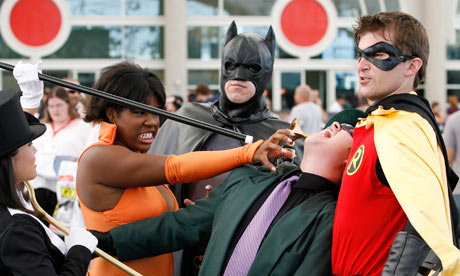
Super troopers ... attendees in costume at the 2009 San Diego Comic Con. Photograph: Denis Poroy/AP
If you haven't read a comic book recently, here's a "heads-up". The current vogue in the world of what used to be known as "four-colour funny books" is for bold blockbuster concepts told with big pictures and as few words as possible. It works, kind of, but those of us who grew up with the great writers of the 1970s and 80s – Don McGregor, Doug Moench, Steve Englehart and Steve Gerber (all of whom receive name checks in Grant Morrison's Supergods) – miss having more words, actual written ideas pasted alongside the pretty pictures.
Most comic books run to just 20 pages now, at least eight of which will feature giant panels with images of super-types punching each other. Maybe four pages will be devoted to setting up why they need to be punching each other. Two will be about how they get to bump into each other before they can have a big old punching party, and a couple more will be dedicated to tying up the loose ends after the last big fight. There isn't really a lot of space left for complicated ideas and eloquent wordplay. So if you are writing comics, and you have a sophisticated and original mind, these days you have no outlet for all those ideas about the plight of mankind, or how punk rock changed your life, or what transcendental meditation might achieve for Batman. And if there's no room for all that fun stuff in your comic books, when and where can you unload?
The answer, it seems, is here. Part history of comics, part memoir, part slightly loopy philosophical work, Supergods is an unusual book. It is also a big book: big on ideas, big on ambition, perhaps too big in terms of length. Even my nearly bottomless interest in, and affection for, comics and those who write and draw them began to ebb a little over nearly 500 pages. That's not to suggest that big is necessarily bad, it's just that it takes a certain amount of commitment to pick this up in the first place, and I suspect that the average reader – those not already hooked on comics or aware that Grant Morrison is one of the finest writers, if not the finest writer, working in comics today – will find it too much of an ask.
That would be a tremendous shame, because Supergods is perhaps the most satisfactory potted history of the American comic book industry I've ever read (and I've read just about all its competitors) while also offering a brilliantly incisive, if very personal, appreciation and analysis of the most important comic books or graphic novels – call 'em what you will – to be published in the past 30 years.
It begins as a fairly straightforward primer, detailed and informed enough to let you feel knowledgable but not so stuffed with minutiae and trivia as to deter a newcomer. For those who want more detail there's an excellent reading list at the back. Morrison dismisses the claims of ownership recently made by the early creators or their families to work published by the big companies. The argument is, in effect: "these creators couldn't wait to get published and they knew what they were signing up for." I disagree with him to some extent, but it's a complex and tricky issue, so it's just as well he doesn't expand on it too much, because the fun really starts later on. He writes with understanding of what it is that makes each of the more successful characters work, and sums up well the contrasting house styles of the big companies, Marvel and DC, detailing the rise in the 60s of the hip, funky, faux-counter-culture Marvel as the stodgy mainstream DC lost its readers.
As befits the man responsible for overhauling so many of the Golden Age heroes for DC (including Superman and Batman), Morrison rejects the usual narrative of comic-book history: that the 1940s and 50s represent a golden age, followed by a silver age in the 60s, then a bronze in the 70s and mid-80s. Morrison renames the latter period the "dark age", which I prefer – bronze, with its association with third place, always seemed to me to devalue what was an explosion of brilliant work.
Morrison's book hits maximum velocity when he writes about the things he knows most about – because he was there. He gives an account of the importance and influence of the British writers who invaded America after cutting their teeth with 2000AD, and he's good, too, on the indie scene over here. This fresh new wave of creators – each one with a complex relationship to the characters and the industry that had meant so much to them as kids – is beautifully described. The boom that Alan Moore, Neil Gaiman and Frank Miller helped to create, those sophisticated storytellers with a grasp of the full potential the medium offered, is recounted with all the heady rush of excitement it deserves: comics weren't for kids any more. But Morrison is also ideally placed to turn his gaze on the aftermath and the countless lesser imitators that followed.
It's a subjective take, and although I'd agree with most of what he says, after a while the author's pet peeves begin to show through and grow a little tiresome. Moore, in particular, is mocked rather churlishly for his announcement that he was leaving the world of superhero books having delivered Watchmen, only for him to return years later when, as Morrison surmises, his publishing venture Mad Love had failed to hit it big with readers. Yet Supergods contains perhaps the most acute analysis of Watchmen I've ever read. Not just how radical it was, and how much of a game-changer it became, but how it works in terms of layout, design, the book's remarkable structure and pace and complexity – many of which qualities reveal themselves only after several readings.
Morrison writes with clarity about his own not inconsiderable contribution to grown-up comic books – the meta-fiction of Animal Man, the delightful surrealism he brought to Doom Patrol and the boundary-bursting ambition that underpins (and in my opinion rather spoils) The Invisibles. These passages are funny and veer successfully between self-deprecation and a recognition of his own brilliance.
But, as the title suggests, this book is not just about comics and superheroes on the printed page. It shifts again to detail Morrison's fearless exploration, via hallucinogens and occult rituals, of the multiverse.
The problem here is that for a sane sceptic, even one who is fascinated by psychedelic transports brought about by such immersive decoctions as DMT, this section of Supergods, which might have been the most memorable, is in fact the dullest. It's not dissimilar to listening to someone giving a long description of their dreams. Shaving your head before dragging up in full fetish gear and wolfing down a magic mushroom omelette may well open the door to another realm, or give you access to demons and guardian angels. I have never tried it so I can't say with absolute certainty. But I am pretty sure that what Morrison was experiencing and is describing is a cross between a nervous breakdown and a common-or-garden trip.
Despite its faults – the length and the occasional self-indulgence – this is a likeable, amusing read. It is a showcase for a writer who really is one of the greats, one of the true originals still working in comics on a regular basis. But I expect that the definitive book about Morrison's work and his contribution to the world of comics will have to come from someone else, someone with a little distance and perspective. I just hope for his sake it's not Alan Moore.
Right Wing Christian Fundamentalist Exhibits Hate in Norway
Norway attacks - in pictures -+- Re-thinking 9/11
Photographs taken after the blast in Oslo and the shooting at the island of Utøya
Boner Republicans Exhibit Hate for United States People by Supporting Debt Ceiling for RICH
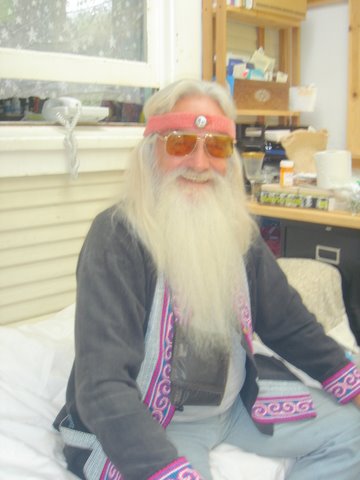
Keith Lampe, Ro-Non-So-Te, Ponderosa Pine, Transition Prez
Happy 80th Birthday Pine! - July 25th
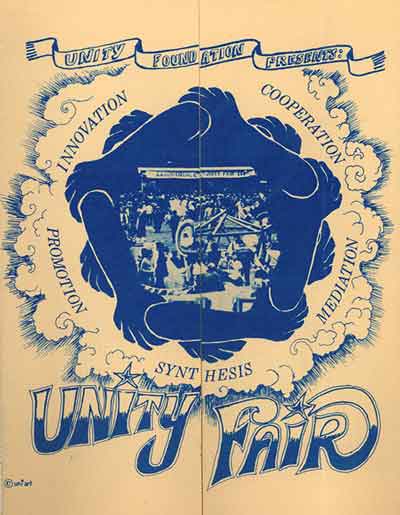
[SNIP]
How We Serve
Unity Foundation brings together humanitarian groups through educational festivals. We present performing and visual arts, workshops, classes, and speakers. The fairs have involved 500,000 people and 250 ecological, political, spiritual, third-world, and community service groups. Together we share information, ideas, and skills, in an environment of self-sufficiency and sharing.
The fairs' production costs, waste, and problems are minimal and color, art, and friendliness are bountiful. The fairs demonstrate how to survive in an urban environment in simplicity and enjoyment. Our publicity states "no drugs or alcohol", keeping the atmosphere. harmonious and clean. Participation is emphasized, breaking down the audience-performer roles found in conventional concerts or fairs. Food and other products are sold on a donation basis. Receptacles are provided for on-site recycling.
[SNIP]

References and Associates
Allen Ames, the Rainbow Family
Dennis Banks, American Indian Movement
Phillip Bloom, Omniversal Family Presents
Tony Brown, Earth News Service
Pat Harrington, New Games Foundation
Wavy Gravy, Merry Prankster, Initiator of the Nobody for President Campaign
Richard Hansen, President of the Preservation Hall Democratic Club and Native Sons of Golden West
Tina Hoffman, Founder of Preservation Hall Democratic Club
Cliff Humphrey, Co-founder of the Peace and Freedom Party and Ecology Action
Paul Krassner, writer, editor of The Realist
Carl Macki, Black Whole Communications, editor of X
David McQueen, KSAN-FM News Dept.
Gene Parsons, musician with the Byrds and the Flying Burrito Bros.
Ponderosa Pine, naturalist and activist.
Tony Serra, San Francisco lawyer and past mayoral candidate
Curtis Spangler, Hiranyaloka Agency of the Arts, United State Cafe - San Francisco
Stevie Wonder, musician, arranger and producer.
[SNIP - Above pamphlet from mid 1970s]
David writes:
Hello,
This is my latest painting: "Mistress, May I?"

"Mistress, May I?" Acrylic on Canvas, 24" x 36" (61 x 91.5 cm) 2011
For more info about this piece (or any of my other work) please visit my blog, http://normal.bz.
Also, I was interviewed recently for the "Vasa Transmedia Global Project." You may read the interview here.
- David Normal
Rebekah Brooks "Friday" (Rebecca Black Parody)
Will the United States prepare Bush Administration subpoenas
for Republicans Hacking U.S. Citizens' Phones during 2000 ???
Telecom Crimes
Violation of the Fourth Amendment to the Constitution
Violation of the First Amendment to the Constitution
Unlawful electronic surveillance or disclosure or use of information obtained by electronic surveillance in violation of 50 U.S.C. §1809.
Unlawful interception, use or disclosure of Class communications in violation of 18 U.S.C. § 2511
Unlawful solicitation and obtained disclosure of the contents of communications in violation of 18 U.S.C. § 2702(a)(1) or (a)(2)
Unlawful solicitation and obtained disclosure of non-content records or other information in violation of 18 U.S.C. § 2702(a)(3)
Violation of the Administrative Procedures Act
Violation of the constitutional principle of separation of powers
Congress votes to immunize lawbreaking telecoms, legalize ...
Jul 9, 2008 ... It plainly violates the Fourth Amendment." EFF, the other non-profit organization behind the telecom lawsuits, announced the same, ...
The Democratic-led Congress this afternoon voted to put an end to the NSA spying scandal, as the Senate approved a bill -- approved last week by the House -- to immunize lawbreaking telecoms, terminate all pending lawsuits against them, and vest whole new warrantless eavesdropping powers in the President. The vote in favor of the new FISA bill was 69-28. Barack Obama joined every Senate Republican (and every House Republican other than one) by voting in favor of it, while his now-vanquished primary rival, Sen. Hillary Clinton, voted against it. John McCain wasn't present for any of the votes, but shared Obama's support for the bill. The bill will now be sent to an extremely happy George Bush, who already announced that he enthusiastically supports it, and he will sign it into law very shortly. [Continue Reading]
http://www.salon.com/opinion/greenwald/2008/07/09/fisa_vote/
Senate Approves Telco Amnesty, Legalizes Bush's Secret Spy Program ...
That amendment got 57 votes, but due to an agreement by Senate Majority ..... It's also not in violation of the constitution, as it only applies to non-citizens. ..... 4th. Every law that alters the legal rules of evidence, and receives ... [Continue Reading]
http://blog.wired.com/27bstroke6/2008/02/senate-approves.html
Wiretapping, Telecom Companies, and You | The Legality
Feb 20, 2008 ... Discussion of warantless wiretapping, telecom immunity, ... Warrantless wiretaps violate the Fourth Amendment guarantee of freedom from ...
The telecom companies have a powerful ally in the U.S. federal government: officers of the federal government who approved wiretaps without a warrant may face widespread civil or criminal liability if any wrongdoing comes out in court. The law takes abuse of power very seriously, and under 50 U.S.C. § 1809, an agent of the government who monitors an illegal wiretap or uses information obtained from unlawful surveillance can be punished with a fine of $10,000, five years in jail, or both. [Continue Reading]
http://www.thelegality.com/archives/26
The Higgs Boson

artwork: CERN
When you get on the scale in the morning, you may be hoping that it registers a smaller number than the day before -- you may be hoping that you've lost weight. It's the quantity of mass in you, plus the force of gravity, that determines your weight. But what determines your mass?
That's one of the most-asked, most-hotly pursued questions in physics today. Many of the experiments circulating in the world's particle accelerators are looking into the mechanism that gives rise to mass. Scientists at CERN, as well as at Fermilab in Illinois, are hoping to find what they call the "Higgs boson." Higgs, they believe, is a particle, or set of particles, that might give others mass.
The idea of one particle giving another mass is a bit counter-intuitive... Isn't mass an inherent characteristic of matter? If not, how can one entity impart mass on all the others by simply floating by and interacting with them?
The Higgs Mechanism
source: CERN

To understand the Higgs mechanism, imagine that a room full of physicists chattering quietly is like space filled with the Higgs field ...

... a well-known scientist walks in, creating a disturbance as he moves across the room and attracting a cluster of admirers with each step ...

... this increases his resistance to movement, in other words, he acquires mass, just like a particle moving through the Higgs field...

... if a rumor crosses the room, ...

... it creates the same kind of clustering, but this time among the scientists themselves. In this analogy, these clusters are the Higgs particles.
An oft-cited analogy describes it well: Imagine you're at a Hollywood party. The crowd is rather thick, and evenly distributed around the room, chatting. When the big star arrives, the people nearest the door gather around her. As she moves through the party, she attracts the people closest to her, and those she moves away from return to their other conversations. By gathering a fawning cluster of people around her, she's gained momentum, an indication of mass. She's harder to slow down than she would be without the crowd. Once she's stopped, it's harder to get her going again.
This clustering effect is the Higgs mechanism, postulated by British physicist Peter Higgs in the 1960s. The theory hypothesizes that a sort of lattice, referred to as the Higgs field, fills the universe. This is something like an electromagnetic field, in that it affects the particles that move through it, but it is also related to the physics of solid materials. Scientists know that when an electron passes through a positively charged crystal lattice of atoms (a solid), the electron's mass can increase as much as 40 times. The same might be true in the Higgs field: a particle moving through it creates a little bit of distortion -- like the crowd around the star at the party -- and that lends mass to the particle.

Scientists at CERN use the enormous ALEPH detector in their search for the Higgs particle. photo: CERN
The question of mass has been an especially puzzling one, and has left the Higgs boson as the single missing piece of the Standard Model yet to be spotted. The Standard Model describes three of nature's four forces: electromagnetism and the strong and weak nuclear forces. Electromagnetism has been fairly well understood for many decades. Recently, physicists have learned much more about the strong force, which binds the elements of atomic nuclei together, and the weak force, which governs radioactivity and hydrogen fusion (which generates the sun's energy).
Electromagnetism describes how particles interact with photons, tiny packets of electromagnetic radiation. In a similar way, the weak force describes how two other entities, the W and Z particles, interact with electrons, quarks, neutrinos and others. There is one very important difference between these two interactions: photons have no mass, while the masses of W and Z are huge. In fact, they are some of the most massive particles known.
The first inclination is to assume that W and Z simply exist and interact with other elemental particles. But for mathematical reasons, the giant masses of W and Z raise inconsistencies in the Standard Model. To address this, physicists postulate that there must be at least one other particle -- the Higgs boson.
The simplest theories predict only one boson, but others say there might be several. In fact, the search for the Higgs particle(s) is some of the most exciting research happening, because it could lead to completely new discoveries in particle physics. Some theorists say it could bring to light entirely new types of strong interactions, and others believe research will reveal a new fundamental physical symmetry called "supersymmetry."

CERN scientists were unsure whether these events recorded by the ALEPH detector indicated the presence of a Higgs
boson.
Check out the links listed below for the latest information on the search for the Higgs Boson. photo: CERN
First, though, scientists want to determine whether the Higgs boson exists. The search has been on for over ten years, both at CERN's Large Electron Positron Collider (LEP) in Geneva and at Fermilab in Illinois. To look for the particle, researchers must smash other particles together at very high speeds. If the energy from that collision is high enough, it is converted into smaller bits of matter -- particles -- one of which could be a Higgs boson. The Higgs will only last for a small fraction of a second, and then decay into other particles. So in order to tell whether the Higgs appeared in the collision, researchers look for evidence of what it would have decayed into.
In August 2000, physicists working at CERN's LEP saw traces of particles that might fit the right pattern, but the evidence is still inconclusive. LEP was closed down in the beginning of November, 2000, but the search continues at Fermilab in Illinois, and will pick up again at CERN when the LHC (Large Hadron Collider) begins experiments in 2005.
EXTERNAL LINKS
For up-to-date information on the search for the Higgs boson: LHC, Fermilab, ALEPH (LEP experiment), OPAL (LEP experiment), L3 (LEP experiment), DELPHI (LEP experiment), Article Source
Cern scientists suspect glimpse of Higgs boson
Unusual data bumps detected by two teams at Large Hadron Collider thought to be glimpse of elusive source of particle mass
Ian Sample, Science correspondent, guardian.co.uk, Friday 22 July 2011 20.09 BST, Article history, Article Source
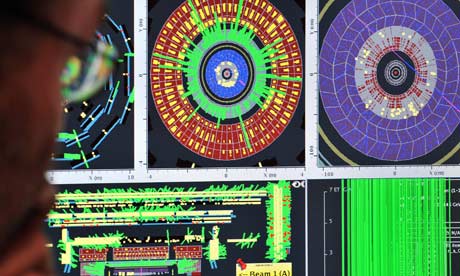
A technician at work in the Atlas control room. 'Bumps' in the data hint at presence of Higgs boson. Photograph: Fabrice Coffrini/AFP/Getty Images
Scientists may have caught their first glimpse of the elusive Higgs boson, which is thought to give mass to the basic building blocks of nature.
Researchers at the Large Hadron Collider at Cern, the European particle physics lab near Geneva, announced the findings at a conference on Friday.
The world's most powerful atom smasher hunts for signs of new physics by slamming subatomic particles together at nearly the speed of light in an 18-mile round tunnel beneath the French-Swiss border.
Speaking at the meeting, teams working on two of the collider's huge detectors, Atlas and CMS, independently reported unusual bumps in their data that could be the first hints of the particle.
Physicists stressed that it was too early to know whether the signals were due to the missing particle.
Bumps that look like new discoveries can be caused by statistical fluctuations in data, flaws in computer models and other glitches, they said.
"We cannot say anything today, but clearly it's intriguing," Fabiola Gianotti, spokeswoman for the 3,000-strong Atlas team, said. She said the picture would become clearer as the groups gathered more data and combined results in the next few months. The view was shared by Guido Tonelli, spokesman for the CMS group, said more data was needed to understand whether the bumps were due to "statistical fluctuations or possible hints of a signal".
The long-sought particle was first postulated in 1964 by Peter Higgs, a physicist at Edinburgh University, in a theory that described how fundamental particles gained mass from an invisible field that pervaded the cosmos.
The field has been compared to a snowfield that clings to particles and slows them down to different extents. Light particles pass through the field swiftly as if they have skis on, while heavy particles trudge through as though walking barefoot.
The boson was nicknamed the "God particle" in 1993 by the Nobel prize-winning physicist, Leon Lederman. The monicker is detested by Higgs. "I find it embarrassing because, though I'm not a believer myself, I think it is the kind of misuse of terminology which I think might offend some people," he said.
From previous work, the Higgs boson was thought to have a mass somewhere between 114 and 185GeV (gigaelectronvolts) – one GeV is roughly equivalent to the mass of a proton, a subatomic particle found in atomic nuclei.
The Atlas team reported a Higgs-like bump in their data between 120 and 140GeV. In a later session, the CMS group announced two bumps in the same region.
Matt Strassler, a theoretical physicist at Rutgers University in New Jersey, commented on his blog: "Exciting … but far too early to be sure this is anything interesting." He added: "This is certainly something we'll be watching."
Our civilization is out of sync
Written by Raphael Montoliu, Friday, 22 July 2011, Article Source
The theory of the survival of the fittest, upon which our contemporary societies are founded, can be better understood when one considers that the ability to survive has less to do with mental abilities than with the proper development of a nervous system and sensory organs perfectly attuned to a given environment.
Creatures such as insects are not known for their intellectual prowess, yet they are master survivors … so are weeds and viruses.
A civilization at once motivated and validated in its most extreme behaviors by such theory essentially acts as an insect, a virus, even as a cancer cell, because it's characterized by a single-mindedness which is the hallmark of all lower organisms, inexorably driven, as all creatures who lack imagination and vision, and as if possessed, to blindly overtake, consume and discard all it encounters regardless of consequences.
Our now worldwide civilization has sought new territories, new people, new resources to exploit and consume from its inception, seeing its victims as weak because vulnerable to aggression, and perceiving itself to be superior because driven by aggression, not as the natural predator that rests when fed and satisfied, but as the bacteria that is never satisfied and never rests, or perhaps as the proverbial damned.
Indeed scientists hope to, some day, be able to extract resources from nearby planets, so we can all perpetuate our extravagant lifestyles, lifestyles that are obviously not sustainable within the limits of the earth resources, not to mention lifestyles that poison the air, the water, the land and will sooner or later make life on earth impossible for humanity, when the planet reaches its threshold of tolerance to such stress.
The idea of endless growth, the ideology of the cancer cell, is indeed a dangerous and destructive myth that has no parallel in nature … except when nature is out of balance, such as when a river floods, when an epidemic overtakes a species.
Within the natural order, the predator does not annihilate the prey to extinction, winter does not overcome summer, trees do not grow until they become too tall and too heavy and fall down … natural growth is limited within the natural order by balance, for indeed only that which is in balance with natural laws survives, and what is out of balance, such as possibly were dinosaurs, is made to disappear.
The concept of an endless growth founded on the survival of the fittest is as profoundly unintelligent as a fisherman would be who would load his boat with fish to the point of sinking under the weight.
This is what our civilization is presently doing, being so out of sync with the so-called environment as to no longer understand the consequences of its actions, looking at environmental disasters, species extinctions, climate change and other problems as separate events having separate causes, unwilling and unable to connect the dots, to point to the origin of this global mess.
Such however is not civilization but technologically advanced barbarism … which many years ago propelled Einstein to say, “It has become appallingly obvious that our technology has exceeded our humanity,” as well as “technological progress is as an axe in the hands of a pathological criminal.”
It will be easier to understand the depth and truth of Einstein's statements if we remember that all we do today, in the name of technology and materialism, of endless growth and greed, will affect the future generations in a way that will, then, most probably be assessed to be criminal.

http://www.cancer.gov/cancertopics/pdq/cam/cannabis/healthprofessional/page4
Cannabis and Cannabinoids (PDQ®) via Amestizo
Laboratory/Animal/Preclinical Studies
Cannabinoids are a group of 21-carbon–containing terpenophenolic compounds produced uniquely by Cannabis sativa and Cannabis indica species.[1,2] These plant-derived compounds may be referred to as phytocannabinoids. Although delta-9-tetrahydrocannabinol (THC) is the primary psychoactive ingredient, other known compounds with biologic activity are cannabinol, cannabidiol (CBD), cannabichromene, cannabigerol, tetrahydrocannabivarin, and delta-8-THC. CBD, in particular, is thought to have significant analgesic and anti-inflammatory activity without the psychoactive effect (high) of delta-9-THC.
Antitumor Effects
One study in mice and rats suggested that cannabinoids may have a protective effect against the development of certain types of tumors.[3] During this 2-year study, groups of mice and rats were given various doses of THC by gavage. A dose-related decrease in the incidence of hepatic adenoma tumors and hepatocellular carcinoma was observed in the mice. Decreased incidences of benign tumors (polyps and adenomas) in other organs (mammary gland, uterus, pituitary, testis, and pancreas) were also noted in the rats. In another study, delta-9-THC, delta-8-THC, and cannabinol were found to inhibit the growth of Lewis lung adenocarcinoma cells in vitro and in vivo .[4] In addition, other tumors have been shown to be sensitive to cannabinoid-induced growth inhibition.[5-8]
Cannabinoids may cause antitumor effects by various mechanisms, including induction of cell death, inhibition of cell growth, and inhibition of tumor angiogenesis and metastasis.[9-11] Cannabinoids appear to kill tumor cells but do not affect their nontransformed counterparts and may even protect them from cell death. These compounds have been shown to induce apoptosis in glioma cells in culture and induce regression of glioma tumors in mice and rats. Cannabinoids protect normal glial cells of astroglial and oligodendroglial lineages from apoptosis mediated by the CB1 receptor.[12]
In an in vivo model using severe combined immunodeficient mice, subcutaneous tumors were generated by inoculating the animals with cells from human non-small cell lung carcinoma cell lines.[13] Tumor growth was inhibited by 60% in THC-treated mice compared with vehicle-treated control mice. Tumor specimens revealed that THC had antiangiogenic and antiproliferative effects. However, research with immunocompetent murine tumor models has demonstrated immunosuppression and enhanced tumor growth in mice treated with THC.[14,15]
In addition, both plant-derived and endogenous cannabinoids have been studied for anti- inflammatory effects. A mouse study demonstrated that endogenous cannabinoid system signaling is likely to provide intrinsic protection against colonic inflammation.[16] As a result, a hypothesis that phytocannabinoids and endocannabinoids may be useful in the prevention and treatment of colorectal cancer has been developed.[17-20]
Appetite Stimulation
Many animal studies have previously demonstrated that delta-9-THC and other cannabinoids have a stimulatory effect on appetite and increase food intake. It is believed that the endogenous cannabinoid system may serve as a regulator of feeding behavior. The endogenous cannabinoid anandamide potently enhances appetite in mice.[21] Moreover, CB1 receptors in the hypothalamus may be involved in the motivational or reward aspects of eating.[22]
Analgesia
Understanding the mechanism of cannabinoid-induced analgesia has been increased through the study of cannabinoid receptors, endocannabinoids, and synthetic agonists and antagonists. The CB1 receptor is found in both the central nervous system (CNS) and in peripheral nerve terminals. Similar to opioid receptors, increased levels of the CB1 receptor are found in regions of the brain that regulate nociceptive processing.[23] CB2 receptors, located predominantly in peripheral tissue, exist at very low levels in the CNS. With the development of receptor-specific antagonists, additional information about the roles of the receptors and endogenous cannabinoids in the modulation of pain has been obtained.[24,25]
Cannabinoids may also contribute to pain modulation through an anti-inflammatory mechanism; a CB2 effect with cannabinoids acting on mast cell receptors to attenuate the release of inflammatory agents, such as histamine and serotonin, and on keratinocytes to enhance the release of analgesic opioids has been described.[26-28]
References
Adams IB, Martin BR: Cannabis: pharmacology and toxicology in animals and humans. Addiction 91 (11): 1585-614, 1996. [PUBMED Abstract]
Grotenhermen F, Russo E, eds.: Cannabis and Cannabinoids: Pharmacology, Toxicology, and Therapeutic Potential. Binghamton, NY: The Haworth Press, 2002.
National Toxicology Program .: NTP toxicology and carcinogenesis studies of 1-trans-delta(9)-tetrahydrocannabinol (CAS No. 1972-08-3) in F344 rats and B6C3F1 mice (gavage studies). Natl Toxicol Program Tech Rep Ser 446 (): 1-317, 1996. [PUBMED Abstract]
Bifulco M, Laezza C, Pisanti S, et al.: Cannabinoids and cancer: pros and cons of an antitumour strategy. Br J Pharmacol 148 (2): 123-35, 2006. [PUBMED Abstract]
Sánchez C, de Ceballos ML, Gomez del Pulgar T, et al.: Inhibition of glioma growth in vivo by selective activation of the CB(2) cannabinoid receptor. Cancer Res 61 (15): 5784-9, 2001. [PUBMED Abstract]
McKallip RJ, Lombard C, Fisher M, et al.: Targeting CB2 cannabinoid receptors as a novel therapy to treat malignant lymphoblastic disease. Blood 100 (2): 627-34, 2002. [PUBMED Abstract]
Casanova ML, Blázquez C, Martínez-Palacio J, et al.: Inhibition of skin tumor growth and angiogenesis in vivo by activation of cannabinoid receptors. J Clin Invest 111 (1): 43-50, 2003. [PUBMED Abstract]
Blázquez C, González-Feria L, Alvarez L, et al.: Cannabinoids inhibit the vascular endothelial growth factor pathway in gliomas. Cancer Res 64 (16): 5617-23, 2004. [PUBMED Abstract]
Guzmán M: Cannabinoids: potential anticancer agents. Nat Rev Cancer 3 (10): 745-55, 2003. [PUBMED Abstract]
Blázquez C, Casanova ML, Planas A, et al.: Inhibition of tumor angiogenesis by cannabinoids. FASEB J 17 (3): 529-31, 2003. [PUBMED Abstract]
Vaccani A, Massi P, Colombo A, et al.: Cannabidiol inhibits human glioma cell migration through a cannabinoid receptor-independent mechanism. Br J Pharmacol 144 (8): 1032-6, 2005. [PUBMED Abstract]
Torres S, Lorente M, Rodríguez-Fornés F, et al.: A combined preclinical therapy of cannabinoids and temozolomide against glioma. Mol Cancer Ther 10 (1): 90-103, 2011. [PUBMED Abstract]
Preet A, Ganju RK, Groopman JE: Delta9-Tetrahydrocannabinol inhibits epithelial growth factor-induced lung cancer cell migration in vitro as well as its growth and metastasis in vivo. Oncogene 27 (3): 339-46, 2008. [PUBMED Abstract]
Zhu LX, Sharma S, Stolina M, et al.: Delta-9-tetrahydrocannabinol inhibits antitumor immunity by a CB2 receptor-mediated, cytokine-dependent pathway. J Immunol 165 (1): 373-80, 2000. [PUBMED Abstract]
McKallip RJ, Nagarkatti M, Nagarkatti PS: Delta-9-tetrahydrocannabinol enhances breast cancer growth and metastasis by suppression of the antitumor immune response. J Immunol 174 (6): 3281-9, 2005. [PUBMED Abstract]
Massa F, Marsicano G, Hermann H, et al.: The endogenous cannabinoid system protects against colonic inflammation. J Clin Invest 113 (8): 1202-9, 2004. [PUBMED Abstract]
Patsos HA, Hicks DJ, Greenhough A, et al.: Cannabinoids and cancer: potential for colorectal cancer therapy. Biochem Soc Trans 33 (Pt 4): 712-4, 2005. [PUBMED Abstract]
Liu WM, Fowler DW, Dalgleish AG: Cannabis-derived substances in cancer therapy--an emerging anti-inflammatory role for the cannabinoids. Curr Clin Pharmacol 5 (4): 281-7, 2010. [PUBMED Abstract]
Malfitano AM, Ciaglia E, Gangemi G, et al.: Update on the endocannabinoid system as an anticancer target. Expert Opin Ther Targets 15 (3): 297-308, 2011. [PUBMED Abstract]
Sarfaraz S, Adhami VM, Syed DN, et al.: Cannabinoids for cancer treatment: progress and promise. Cancer Res 68 (2): 339-42, 2008. [PUBMED Abstract]
Mechoulam R, Berry EM, Avraham Y, et al.: Endocannabinoids, feeding and suckling--from our perspective. Int J Obes (Lond) 30 (Suppl 1): S24-8, 2006. [PUBMED Abstract]
Fride E, Bregman T, Kirkham TC: Endocannabinoids and food intake: newborn suckling and appetite regulation in adulthood. Exp Biol Med (Maywood) 230 (4): 225-34, 2005. [PUBMED Abstract]
Walker JM, Hohmann AG, Martin WJ, et al.: The neurobiology of cannabinoid analgesia. Life Sci 65 (6-7): 665-73, 1999. [PUBMED Abstract]
Meng ID, Manning BH, Martin WJ, et al.: An analgesia circuit activated by cannabinoids. Nature 395 (6700): 381-3, 1998. [PUBMED Abstract]
Walker JM, Huang SM, Strangman NM, et al.: Pain modulation by release of the endogenous cannabinoid anandamide. Proc Natl Acad Sci U S A 96 (21): 12198-203, 1999. [PUBMED Abstract]
Facci L, Dal Toso R, Romanello S, et al.: Mast cells express a peripheral cannabinoid receptor with differential sensitivity to anandamide and palmitoylethanolamide. Proc Natl Acad Sci U S A 92 (8): 3376-80, 1995. [PUBMED Abstract]
Ibrahim MM, Porreca F, Lai J, et al.: CB2 cannabinoid receptor activation produces antinociception by stimulating peripheral release of endogenous opioids. Proc Natl Acad Sci U S A 102 (8): 3093-8, 2005. [PUBMED Abstract]
Richardson JD, Kilo S, Hargreaves KM: Cannabinoids reduce hyperalgesia and inflammation via interaction with peripheral CB1 receptors. Pain 75 (1): 111-9, 1998. [PUBMED Abstract]
Marijuana and PTSD: Give the Joy of Life a Chance
by John Grant - Posted Fri, 07/22/2011 - 22:58 by Anonymous - via Hal - Article Source
With great lawyers you have
Discussed lepers and crooks.
You've been through all of
F. Scott Fitzgerald's books.
You're very well read
It's well known.
But something is happening here
And you don't know what it is
Do you, Mister Jones?
- Bob Dylan, Ballad of a Thin Man
Every once in a while a news story pops up that makes you laugh because it opens up a window on an absurdity of modern life. In this case, the absurdity involves two major national issues: Helping war-stressed combat veterans cope with life back home and the 40-year-old War On Drugs.
The New York Times reported recently that a group of researchers want to launch a study on the benefits of marijuana for Iraq and Afghanistan combat veterans who suffer Post Traumatic Stress Disorder. The question looming over the study is will a stubborn federal government mired in the Drug War allow the study to even get off the ground.
The Times reports on an Iraq veteran in Texas suffering from a leg wound and several head injuries who told them “marijuana helped quiet his physical and psychological pain, while not causing weight loss and sleep deprivation brought on by his prescription medications” It seems the "munchies" can be beneficial to someone facing loss of appetite and emaciation.
“ ‘I have seen it with my own eyes,' he said. ‘It works for a lot of the guys coming home.' ”
I know a number of Vietnam and Iraq veterans who use marijuana. From my very unscientific survey it seems quite plausible that marijuana could be scientifically shown to bring a sense of calmness and pleasantness into a life burdened with harsh combat memories.
One vet who uses it fairly frequently says it helps him concentrate on creative matters. He says he's not sure how much it actually helps his PTSD. He feels that is a matter of effectively addressing the issues causing the PTSD; in other words, marijuana or anything else is no replacement for the hard work necessary in recognizing why something is troubling an individual. But, still, he feels marijuana is a responsible, positive factor in his life.

Dr. Rick Doblin, left.
Another veteran who has used marijuana off and on for decades sees its usage as positive for balancing out life's frustrations and difficulties. He laughs and says his wife will testify to how nice it makes him. But, he adds, it can be abused. “Too much of the stuff and it will make you stupid,” he said. “What's important is to 'understand thyself,' then come to an understanding what effects, good and bad, marijuana has for you.”
All it takes is listening to the incredible litany of horrific warnings about the side effects of legal pharmaceuticals in current TV advertisements to understand what he means. Everything can be abused and different people react to different things in different ways. The difference between legal drugs and illegal drugs is simple: One is legal and designed by a corporation to make money, while the other has been deemed illegal and, thus, is distributed by a criminalized class that makes the profits.
It's about ingesting a chemical that interacts with the body's chemistry. In the case of psychotropic drugs, this interaction shifts the balance of certain aspects of consciousness. The body doesn't care if the stuff is legal or illegal or who is making money off its use. If it has a benefit, that's good.
Rick Doblin is the moving force behind the marijuana study. He has a doctorate in public policy from Harvard. For years, he has worked to legalize marijuana. Once he got his PhD, he set up the Multidisciplinary Association for Psychedelic Studies (MAPS) in Santa Cruz, California. The study proposed by Dr. Doblin and MAPS would involve 50 combat veterans whose PTSD has not responded to other treatments. It would be a blind study with placebos.
To get a feel for Dr. Doblin, listen to him explaining his MAPS program at a conference in Israel, then at another in Canada and a third that addresses his long-term efforts to legalize marijuana.
Hard core drug warriors may smile and say, hey, this guy is a hippie! Doblin would probably give his trademark smirk. At one juncture in a video, he calls himself an "affirmative action hippie” they let into Harvard. He may smile easily, but the man is quite serious.
“With so many veterans from the wars in Iraq and Afghanistan, there is a widely accepted need for a new treatment of PTSD,” Doblin told The Times. “These are people whom we put in harm's way, and we have a moral obligation to help them.”
So far, the Food and Drug Administration has OKed the study. The current hurdle is the Department of Health and Human Services, which must give the OK in order for Doblin and his team to obtain the marijuana for the study. It's not a matter of hooking up with a local dealer and obtaining the stuff. The marijuana has to come from the official US Government crop at the University of Mississippi.
If, instead of studying the beneficial aspects of marijuana, Dr. Doblin wanted to study its harmful effects, it's clear he would have a much easier time of it with the Feds.
Getting to the Nitty Gritty
In his introductory remarks at the conference in Israel, Dr. Doblin gets to a key idea as to why asking questions about the benefits of marijuana use can be so troublesome to some. It has to do with the fact combat veterans are people trained and acculturated to war and its de-humanizing violence. It also has to do with a cultural addiction to violence and a fear of the unifying aspects of life.
“I'm not a psychologist or a therapist dealing with individual patients," he told the Israeli attendees. "I'm a public policy person dealing with sick public policies."
In his Israel remarks, he cites the rise of religious fundamentalism. He is fair and mentions all of the big three: Islam, Judaism and Christianity. “I think this rise of fundamentalism is pretty much the core problem in the world right now,” he says. He means the separation and division of people from other people. He sees marijuana as a counter to this us-versus-them sense of difference between peoples that is so much an engine for violence and warfare.
“For many of us, psychedelics – and marijuana especially – have helped us have experiences of connection, mystical experiences where you feel part of everything, and that there's a deeper sense of identity than our religion or our country or our gender or our race; and that once you have this deeper sense of identity, you're more likely to be tolerant, you're more likely to appreciate differences rather than be scared by differences. And that's where peacemaking can come from.”
My wife has said for years the reason marijuana is illegal is that it makes an individual less in awe of power and authority and more in awe of the process of living, and the beauty and joy that goes along with that process. For me, it has a lot to do with Freud's idea of the life instinct versus the death instinct.
“[T]he inclination to aggression is an original, self-subsisting instinctual disposition in man," Freud writes in Civilization And It's Discontents. This aggression, he says, "constitutes the greatest impediment to civilization.”
He goes on to say “civilization is a process of Eros, whose purpose is to combine single human individuals, and after that, families, then races, peoples and nations, into one great unity, the unity of mankind. ...[T]he struggle between Eros and Death, between the instinct of life and the instinct of destruction ... is what all life essentially consists of."
Jungian analyst Loren E. Pedersen in Dark Hearts: The Unconscious Forces That Shape Men's Lives puts a Jungian spin on the destructive death instinct and sees it as the masculine focus on power as “a result of [men's] failure to incorporate the feminine in themselves.”
The point is, if we're going to seriously address issues of post-traumatic-stress resulting from combat experience, the old, currently passé notions of deep, unconscious forces at work in our day-to-day activities and decisions may be worth revisiting. And if something like a toke of marijuana helps inject a little Eros into a life stuck in the hell of death -- that is a good thing.
The days of pure behaviorist manipulation and the treatment of mental problems with harsh, numbing prescription drugs may be in need of revision. The smiling Dr. Doblin may be right: Marijuana may help a troubled combat vet regain some sense of belonging to a greater species of humanity than that represented by the flag and the Marine Corps Hymn. But, then, we're back to the subversive quality of marijuana. But maybe some people need a little subversiveness to help them climb out of the hell they find themselves caught in.
In his fine book War Is A Force That Gives Us Meaning, war correspondent Chris Hedges nicely resurrects Freud's notion of Eros and Thanatos, the Greek term sometimes used for the death instinct. For Hedges, the former is “the impulse within us that propels us to become close to others” and the latter is “the impulse that works toward the annihilation of all living things, including ourselves."
Soldiers in war can be traumatically overwhelmed by violence and death. "The lust for violence, the freedom to eradicate the world around them, even human lives, is seductive,” Hedges reports. “War ascendant wipes out Eros. War celebrates only power."
In the end, Dr Doblin's proposal is not funny. It should be taken seriously and his team allowed what it needs to see if marijuana is beneficial in easing the destructive impact of war on our veteran's lives. It's also bad policy to be criminalizing so many of our veterans who choose to "self-medicate" themselves. A little sanity in this area can go a long way.
This essay is co-posted on IN THE MIND FIELD at: www.inthemindfield.com
Spooks Gone Wild - August 1, 2007
Court Ruling that NSA Wiretapping is Illegal
Drives Emergency Push for New Spy Powers, Newsweek Reports
By Ryan Singel, August 1, 2007, Wired Article Source
 The Bush Administration's hard press for emergency wiretapping powers from Congress before the August break now has an explanation: a secret court decided several months ago that at least one portion of the NSA wiretapping program is illegal, according to
The Bush Administration's hard press for emergency wiretapping powers from Congress before the August break now has an explanation: a secret court decided several months ago that at least one portion of the NSA wiretapping program is illegal, according to MSNBC Newsweek. That program operated for four years without court supervision, until the Administration bowed to public pressure in January 2007 and allowed the secret Foreign Intelligence Surveillance Court to review it.
In short, prior to the Patriot Act passage, the Administration launched a series of secret, warrantless wiretapping operations, which included snooping on Americans and wholesale data mining of innocent Americans' communications records (the latter only according to press reports). The Administration believes it can do this surveillance since it is a King in wartime and thus never asked Congress to make any of this legal in the Patriot Act for fear it would be turned down.
Years later, a part of this secret surveillance is revealed by the New York Times. After a year of criticism and revelations, the Administration agrees to let a super-secret and very compliant court oversee the program using some very super secret, and legally dubious program warrants. A few months later, a judge from this court finds portions of the program illegal. The administration refuses to make this decision public. Instead, it goes on offense and says it needs the power to wiretap anyone overseas including Americans. A Republican Congressman accidentally leaks the a hint of the decision on Fox News, while saying that Democrats are putting the country at risk. Newsweek's Michael Isikoff and Mark Hosenball (published on MSNBC.com) followed up with good reporting.
The order by a judge on the top-secret Foreign Intelligence Surveillance Act court has never been publicly acknowledged by administration officials—and the details of it (including the identity of the judge who wrote it) remain highly classified. But the judge, in an order several months ago, apparently concluded that the administration had overstepped its legal authorities in conducting warrantless eavesdropping even under the scaled-back surveillance program that the White House first agreed to permit the FISA court to review earlier this year, said one lawyer who has been briefed on the order but who asked not to be publicly identified because of its sensitivity.
Now, we know why there's an intelligence gap. Democrats afraid of looking soft on terrorism are now at work to give more spying power to the government to fill the mineshaft gap.
Once again: a secret court judge found that the Bush Administration's formerly warrantless wiretapping program was illegal.
And that was the program AFTER it was scaled down in March 2004 after Justice Department officials revolted. I wonder what judges would have made of the earlier program -- the one so bad that then-Attorney General John Ashcroft was ready to resign.
If there's an intelligence gap, and I'm not sure there is, it's only due to the Administration's hubris.
Photo: Joe Mad - More Information: Denialist Reconstruction & Telecom Crime & Punishment
Mike Wilhelm writes:
A new song, Buckaroo Life, http://soundcloud.com/guitar-willie/buckaroo-life
Buckaroo: A corruption of the Spanish word "vaquero", meaning "cowboy".
An original song by Michael Ray Wilhelm
John Boehner Pulls A Boner In Congress

Steve Bell cartoon on the US debt crisis
Hardline revolt puts more pressure on Republican speaker of the house John Boehner
The Daily Take: John Boehner
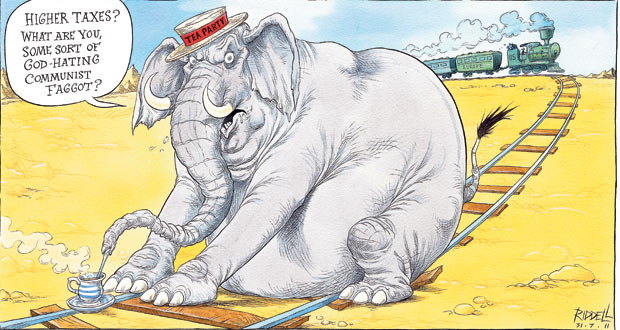
Coming down the track. A Chris Riddell cartoon on the US economy
Why Does Republican Tea Party Want To Destroy Remaining United States Economy?
Is it because they want to finish what a Republican Bush Administration started ???
Bi-Partisan Unity

WHAT, You've never seen Animal Planet?
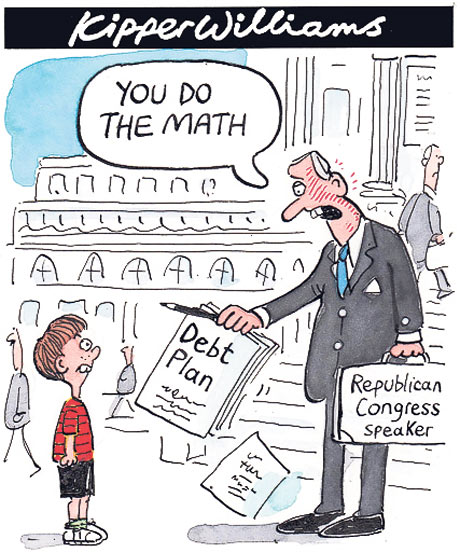
Republican debt plan fails to add up - Cartoon by Kipper Williams
Deadlock over US borrowing continues as hole is found in proposals
California takes out insurance against US debt deal failure
State raises $5.4bn bridging loan from banks to cover 'drastic consequences' of missing 2 August deadline
Ed Pilkington in New York, guardian.co.uk, Thursday 28 July 2011 00.20 BST, Article history, Article Source
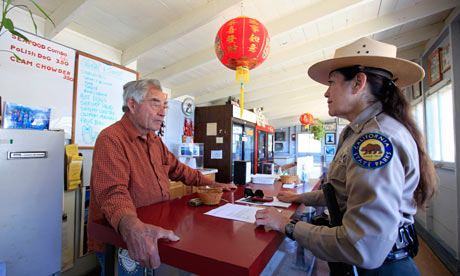
Before 2 August, already short of money: superintendent Danita Rodriguez chats to a store
owner at China Camp, a former shrimping village on the north shores of San Francisco Bay,
one of 70 California state parks slated for closure next year. Photograph: Eric Risberg/AP
The continuing deadlock over raising the United States' debt ceiling is prompting drastic action across the nation, as individual states prepare for the worst.
California has taken out a $5.4bn bridging loan as an insurance policy should agreement over a deficit reduction package not be reached by the 2 August deadline.
The state has borrowed from eight banks, led by Goldman Sachs and Wells Fargo, as an emergency stop-gap. Normally in August it would sell $5bn of short-term bonds to keep itself afloat, but California's treasury officials are fearful that failure to reach a deal in Washington could cut the state off from the bond markets.
California's treasurer, the Democratic politician Bill Lockyer, said that the loan was needed to protect the state from the "immediate, drastic consequences" of failure to break the impasse. If unsolved by 2 August, he predicted, America would be pushed into a "financial and economic abyss".
The risk that the federal government might quickly become unable to pay its bills is causing jitters in many states. Maryland and Virginia are the most directly in the firing line, as due to their proximity to Washington they both house large numbers of federal workers whose salaries – and thus state taxes – might be suspended.
States and cities could potentially be badly hit in different ways, including cuts to Medicaid payments to poor families for health care, and postponement of federal funds for motorway building which is at its peak at this time of year.
Is Congress the New Communist Tea Party of America?
Congress has an approval rating lower than the acceptable amount of Rat Feces tolerated in the U.S. food supply.
House panel approves broadened ISP snooping bill
by Declan McCullagh, JULY 28, 2011 1:41 PM PDT, Article Source
Internet providers would be forced to keep logs of their customers' activities for one year--in case police want to review them in the future--under legislation that a U.S. House of Representatives committee approved today.
The 19 to 10 vote represents a victory for conservative Republicans, who made data retention their first major technology initiative after last fall's elections, and the Justice Department officials who have quietly lobbied for the sweeping new requirements, a development first reported by CNET.

House Judiciary committee prepares to vote on sweeping data retention mandate. (Credit: U.S. House of Representatives)
A last-minute rewrite of the bill expands the information that commercial Internet providers are required to store to include customers' names, addresses, phone numbers, credit card numbers, bank account numbers, and temporarily-assigned IP addresses, some committee members suggested. By a 7-16 vote, the panel rejected an amendment that would have clarified that only IP addresses must be stored.
It represents "a data bank of every digital act by every American" that would "let us find out where every single American visited Web sites," said Rep. Zoe Lofgren of California, who led Democratic opposition to the bill.
Lofgren said the data retention requirements are easily avoided because they only apply to "commercial" providers. Criminals would simply go to libraries or Starbucks coffeehouses and use the Web anonymously, she said, while law-abiding Americans would have their activities recorded.
To make it politically difficult to oppose, proponents of the data retention requirements dubbed the bill the Protecting Children From Internet Pornographers Act of 2011, even though the mandatory logs would be accessible to police investigating any crime and perhaps attorneys litigating civil disputes in divorce, insurance fraud, and other cases as well.
"The bill is mislabeled," said Rep. John Conyers of Michigan, the senior Democrat on the panel. "This is not protecting children from Internet pornography. It's creating a database for everybody in this country for a lot of other purposes."
ISP snooping time line
In events that were first reported by CNET, Justice Department officials have been lobbying to require Internet providers to track of what Americans are doing online. Here's the time line:
June 2005: Justice Department officials quietly propose data retention rules.
December 2005: European Parliament votes for data retention of up to two years.
April 2006: Data retention proposals surface in Colorado and the U.S. Congress.
April 2006: Attorney General Gonzales says data retention "must be addressed."
April 2006: Rep. DeGette proposes data retention amendment.
May 2006: Rep. Sensenbrenner drafts data retention legislation--but backs away from it two days later.
May 2006: Gonzales and FBI Director Mueller meet with Internet and telecommunications companies.
February 2009: Two data retention bills target ISPs, hotels, coffee shops
February 2009: Copyright holders would benefit from data retention
January 2011: Justice Department calls for mandatory data retention
February 2011: White House undecided on data retention
May 2011: Wireless providers exempted from Rep. Smith's bill
July 2011: National Sheriffs' Association endorses data retention
Supporters of the measure characterized it as something that would aid law enforcement in investigating Internet crimes. Not enacting it "would keep our law enforcement officials in the dark ages," said its primary sponsor, House Judiciary chairman Lamar Smith (R-Texas).
"Both Democratic and Republican administrations have called for data retention for over a decade," said Smith, who noted that groups including the National Sheriffs' Association, the Major County Sheriffs' Association, and the Fraternal Order of Police have endorsed the concept.
For a while, it seemed like opposition from a handful of conservative members of Congress, coupled with Democrats concerned about civil liberties, would derail the bill.
Rep. F. James Sensenbrenner, a Wisconsin Republican and previous chairman of the House Judiciary committee, had criticized it at a hearing earlier this month, and again in the voting session that began yesterday and continued through this morning.
"I oppose this bill," said Sensenbrenner. "It can be amended, but I don't think it can be fixed... It poses numerous risks that well outweigh any benefits, and I'm not convinced it will contribute in a significant way to protecting children."
So did Rep. Jason Chaffetz (R-Utah), who has made privacy a signature issue and introduced a geolocation bill last month after trying to curb the use of airport body-scanners two years ago.
The original version of the bill, introduced in May, required Internet providers to "retain for a period of at least 18 months the temporarily assigned network addresses the service assigns to each account, unless that address is transmitted by radio communication." The wireless exemption appeared to be the result of lobbying from major carriers, but drew the ire of the Justice Department, which says it didn't go far enough, and was removed in a revised draft.
The mobile exemption represents a new twist in the debate over data retention requirements, which has been simmering since the Justice Department pushed the topic in 2005, a development that was first reported by CNET. Proposals publicly surfaced in the U.S. Congress the following year, and President Bush's attorney general, Alberto Gonzales said it's an issue that "must be addressed." So, eventually, did FBI director Robert Mueller.
In January 2011, CNET was the first to report that the Obama Justice Department was following suit. Jason Weinstein, the deputy assistant attorney general for the criminal division, warned that wireless providers must be included because "when this information is not stored, it may be impossible for law enforcement to collect essential evidence."
Smith introduced a broadly similar bill in 2007, without the wireless exemption, calling it a necessary anti-cybercrime measure. "The legislation introduced today will give law enforcement the tools it needs to find and prosecute criminals," he said in a statement at the time.
"Retention" vs. "preservation"
At the moment, Internet service providers typically discard any log file that's no longer required for business reasons such as network monitoring, fraud prevention, or billing disputes. Companies do, however, alter that general rule when contacted by police performing an investigation--a practice called data preservation.
A 1996 federal law called the Electronic Communication Transactional Records Act regulates data preservation. It requires Internet providers to retain any "record" in their possession for 90 days "upon the request of a governmental entity."
Because Internet addresses remain a relatively scarce commodity, ISPs tend to allocate them to customers from a pool based on whether a computer is in use at the time. (Two standard techniques used are the Dynamic Host Configuration Protocol and Point-to-Point Protocol over Ethernet.)
In addition, an existing law called the Protect Our Children Act of 2008 requires any Internet provider who "obtains actual knowledge" of possible child pornography transmissions to "make a report of such facts or circumstances." Companies that knowingly fail to comply can be fined up to $150,000 for the first offense and up to $300,000 for each subsequent offense.
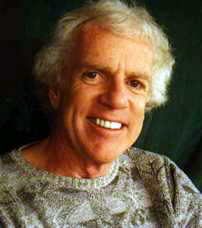
In Memory of A Good Friend: Dr. Brian O'Leary
www.brianoleary.info, www.montesuenos.org, drbrianoleary.wordpress.com, montesuenos.wordpress.com
Freedom of expression and freedom of speech aren't really important unless they're heard...It's hard for me to stay silent when I keep hearing that peace is only attainable through war. And there's nothing more scary than watching ignorance in action. So I dedicated this Emmy to all the people who feel compelled to speak out and not afraid to speak to power and won't shut up and refuse to be silenced. - Tommy Smothers
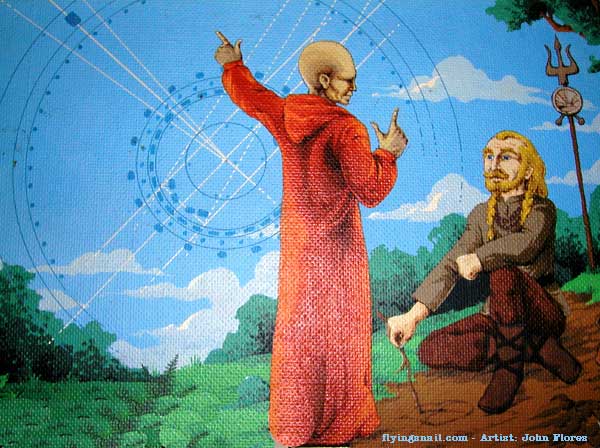
The man whispered, "God, speak to me" and a meadowlark sang. But the man did not hear. So the man yelled "God, speak to me" and the thunder rolled across the sky. But the man did not listen. The man looked around and said, "God let me see you" and a star shined brightly. But the man did not notice. And the man shouted, "God show me a miracle" and a life was born. But the man did not know. So the man cried out in despair, "Touch me God, and let me know you are there" Whereupon God reached down and touched the man. But the man brushed the butterfly away and walked on.

Don't miss out on a blessing because it isn't packaged the way you expect.

